This page is being developed as a guide to mammals of Minnesota by the students of Writing Studies 3562W, section 9, at the University of Minnesota.
Marsupials
Opossums
Virginia Opossum
| Didelphis virginiana (Virginia Opossum) | |
|---|---|
|
Family: Opossum (Didelphidae)
Size: Total Length: 2.5 feet (76 centimeters)
Tail Length: 1 foot (30.48 centimeters) Weight: 8-13.2 pounds (4-6 kilograms)Description: Greyish-white fur that is long and dense. Has a long, pointed face with whiskers. Tail is long and has very little fur.[1]
Similar Species: Opossums are characterized by their long tail, which can act like a third appendage when hanging from a tree.
Range: The opossum can be found as far north as the Canadian border, and as far south as Costa Rica. It can be found throughout the United States.
Habitat: Opossum do not have a specific habitat. They can be found in cities and rural areas. They populate wooded areas along creeks and lakes.
Diet: Opossum are omnivores. They eat grass and fruit as well as mice, worms, and chickens. They are scavengers and can often be found by road kill or garbage cans and dumpsters.[2]
Activity: Opossum do not migrate or have a specific territory. They are nocturnal.
Reproduction: Gestation period is 12-13 days from the months of February to July. The young are as small as honeybees when they are born. After birth they crawl into the females pouch, where they continue to develop and start to nurse. Litter sizes can be as large as 20, though half do not survive. They leave their mother 90-105 days after birth.[3]
Lifespan: 2-3 years |
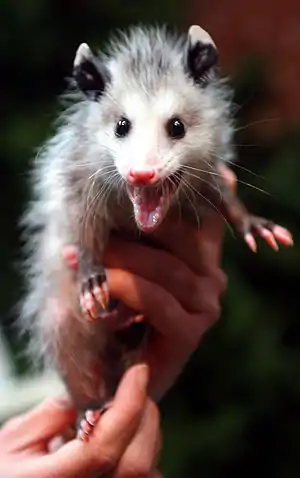 Baby Opossum |
- ↑ Krause, W. J.; Krause, W. A. (2006), The Opossum: Its Amazing Story, University of Missouri, Columbia, Missouri: Department of Pathology and Anatomical Sciences, School of Medicine
- ↑ National Geographic (2012), Opossum, http://animals.nationalgeographic.com/animals/mammals/opossum/, retrieved 9-23-12
- ↑ National Geographic (2012), Opossum, http://animals.nationalgeographic.com/animals/mammals/opossum/, retrieved 9-23-12
Rodents
Beavers
American Beaver
| Castor canadensis (American Beaver) | |
|---|---|
|
Family: Beaver
Size: The total length of the American Beaver is 3-4 feet (1000-1200mm).
Its average tail length is 10-13 inches (258-325mm).[1] The average weight is 40-50 pounds average (18.1-22.7 Kg); may be up to 90 pounds (40.8 Kg).[2]Description: This species is a large rodent with yellow-brown to black fur. Young beavers have black fur that lightens with age. The under fur is dense while the guard hair is long and coarse. The American Beaver has large teeth and a large, flat, scaled, and hairless tail. The hind feet are webbed for swimming and the front feet are small. All of the feet have claws.[1]
Similar Species: The American Beaver is the largest rodent in North America. Its large teeth and large, flat tail distinguish it from other similar species.
[2]
Range: The American Beaver is generally found throughout North America. The only exceptions are in the peninsula of Florida, the southwest deserts of the United States, and the Arctic Circle.[3]
Habitat: This species lives near lakes, ponds, and streams. They must be near trees for building and a food and water source. American Beavers often reconstruct their habitat to create dams.[3]
Diet: The American beaver is a herbivore. This species will eat most types of plants that surround their habitat including leaves, twigs, bark of trees, and aquatic plants. Their diet varies among seasons. In the summer, American Beavers eat mostly willow leaves and twigs and herbaceous vegetation. In the fall, they store lots of branches and bark to eat in the winter.
[1]
Activity: During the spring, summer, and fall the American Beaver is active about 12 hours a day. They are considered to be nocturnal and diurnal because they are active during parts of the day and night. Beavers activity occurs from early evening until early morning. During the day, they rest in their homes.[1]
Reproduction: American Beavers reproduce only once per year producing a litter of 3-4. They reach sexual maturity around 1 1/2 years old which means they breed during their second winter. Breeding usually occurs from January to February with an average gestation of 107 days. Babies are usually born between May and June although this may vary between February and November.[1]
Lifespan: The average American Beaver lives for twelve years.[2]
Notes: The American Beaver has adapted to have its ears and nose close when going underwater. They may stay under water up to 20 minutes at a time. Babies will swim under water for the first time on the day they are born. Beavers are active woodcutters and dam builders. When they overpopulate an area, they build too many dams which cause floods for the area.
Beavers are listed under least concern on the IUCN Red List. |
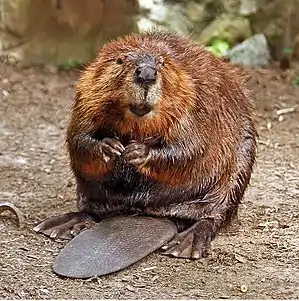 American Beaver |
- 1 2 3 4 5 Jenkins, S; Busher, P (1979), "Castor Canadensis", Mammalian Species 120: 1–8, http://www.science.smith.edu/msi/pdf/i0076-3519-120-01-0001.pdf, retrieved October 4, 2012
- 1 2 3 Minnesota Department of Natural Resources (2012), Beaver, http://www.dnr.state.mn.us/mammals/beaver.html, retrieved October 4, 2012
- 1 2 Linzey, A; NatureServe; Hammerson, G; Cannings, S (2011), Castor Canadensis, http://www.iucnredlist.org/details/summary/4003/0, retrieved October 9, 2012
Squirrels
Woodchuck
| Marmota monax (Woodchuck) | |
|---|---|
|
Family: Squirrel (Sciuridae)
Size: Woodchucks weigh anywhere from 4 to 13 lbs (2-6 kg), and range from 16 to 27 inches (415-675 mm) in total length. Their tail length ranges from 4 to 6 inches (100-160 mm) in length.[1]
Description: Woodchucks are stout in appearance. Their fur color varies greatly, but ranges from gray to cinnamon to dark brown. They have white-tipped guard hairs giving them a grizzled appearance. Their paws are typically black to dark down. They have a short bushy tail that is often black or dark brown. The species also has white teeth and rounded ears.[1]
Similar Species: Unlike most rodents, woodchucks have white teeth. Their paws are also black, unlike a subspecies that has pink.[1]
Range: The woodchuck ranges from central Alaska, east through Canada south of the northwest territories; in the eastern United States south to Georgia, Alabama, Louisiana, and Arkansas; in the western United States absent from the Great Plains, extending down to northern Idaho.[2]
Habitat: The woodchuck is typically found in farmlands, small woodlots, forests, fields, pastures, and hedgerows. It constructs its dens in well-drained soils. They have separate dens for the winter and summer. Winter dens are located near protective cover, while summer dens are located near food sources.[1][2]
Diet: Woodchucks are primarily herbivores, eating a wide variety of herbs, grasses, leaves, bark, and nuts. They also eat insects and mollusks.[1][2]
Activity: Woodchucks are diurnal. They feed twice daily during the summer, and mate soon after hibernation. Generally, woodchucks hibernate, however in the southern range, they have been known to remain active throughout the entire year due to a warmer climate.[1]
Reproduction: The woodchuck’s breeding season extends from early March to mid-April. gestation lasts 31-32 days. Their litter size varies from 2-6, with an average litter size of 4 per year. The young become independent after two months, and sexually mature in one year.[1][2]
Lifespan: Woodchucks live 4 to 6 years in the wild.[1]
Notes: Woodchucks are non-social animals. They have a high tendency to be territorial, and use secretions from their facial and anal glands to designate territorial boundaries. Their sight is used to spot predators and make visual threats to other species. Woodchucks avoid predators by staying elevated in trees and constantly checking their surroundings while feeding. They often use their teeth to defend themselves. Known predators include hawks, snakes, bobcats, black bears, lynx, foxes, wolves, and coyotes.[1]
Woodchucks have both positive and negative economic importance for Humans. The positive economic importance for humans is that they have been used in biomedical research to investigate hepatitis B, obesity, energy balance, the endocrine system, reproduction, cardiovascular disease, cerebrovascular disease, and neoplastic disease. The negative economic importance for humans is that they are known to destroy farmlands, garden, and pastures.[1] There are currently no major threats to this species according to the IUCN Red List of Threatened Species.[2] |
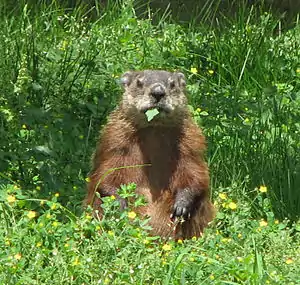 Woodchuck |
- 1 2 3 4 5 6 7 8 9 10 Tobias, C. (2011), versity.ummz.umich.edu/accounts/Marmota_monax/ ADW: Marmota monax: INFORMATION, http://animaldi versity.ummz.umich.edu/accounts/Marmota_monax/, retrieved October 7, 2012
- 1 2 3 4 5 Linzey, A.V.; Cannings, S. (2008), Marmota monax (Woodchuck), http://www.iucnredlist.org/details/42458/0, retrieved October 7, 2012
Franklin's Ground Squirrel
| Spermophilus franklinii[1] (Franklin's Ground Squirrel) | |
|---|---|
|
Family: Squirrel (Sciuridae) [1]
Size: Length: Ranges from 14-16 inches (355-410 mm). Average is 14.6 inches (371 mm). Average Weight: Males is 12.3-33.5 oz. (350-950 g). Females is 12-26.8 oz. (340-760 g).[2]
Description: Dark brownish grey fur speckled with pale and dark flecks. Fur on sides of body is pale. Tail is blackish mixed with pale flecks. Head is typically grayer than the rest of their body.[3]
Similar Species: Franklin’s Ground Squirrel is similar to the Gray Tree Squirrel except that Franklin’s Ground Squirrel is smaller and has shorter ears and tail.[4]
Range: Occurs in the United States and Canada. From Kansas, Missouri, and Illinois northward to Alberta, Saskatchewan, and Manitoba.[3]
Habitat: Tall, dense cover grasses, shrubs, and small trees. Tallgrass and mid-grass prairie. Occupy prairie, woodland edges, forest openings, thickets, and bog borders. Avoid short grass.[5] Agriculture suitable habitats include fence rows to old fields,[4] cemetery prairies, and ditch banks.[5]
Diet: Most carnivorous of ground squirrels. Green plants, seeds, fruit, insects, amphibians, bird eggs, young birds and mammals, and carrion.[5]
Activity: It is Diurnal.[5] Begins hibernation by late September.[3] Emerge from hibernation during April.[5]
Reproduction: Breeding starts immediately after hibernation and lasts until early June. Gestation lasts 28 days.[1] Litter size is 5-11, average is 7. One litter per year. Weaned in 40 days.[3] Born naked and blind. Fully furred after 16 days. Eyes open after 18-20 days.[1]
Lifespan: Females 4-5 years. Males 1-2 years.[1] |
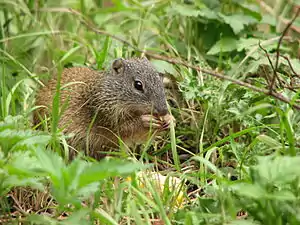 Cute little Franklin's Ground Squirrel eating. |
- 1 2 3 4 5 Ostroff, A. C.; Finck, E. J. (2003), "Spermophilus franklinii", The American Society of Mammalogists, http://www.science.smith.edu/departments/Biology/VHAYSSEN/msi/pdf/724_Spermophilus_franklinii.pdf, retrieved September 24, 2012
- ↑ "North American Mammals:Spermophilusfranklinii", Smithsonian Institution National Museum of Natural History NMNH, http://www.mnh.si.edu/mna/image_info.cfm?species_id=337, retrieved September 24, 2012
- 1 2 3 4 Spermophilus franklinii, 2008, http://www.iucnredlist.org/details/41787/0, retrieved September 24, 2012
- 1 2 Franklin's Ground Squirrel, http://www.chiwaukee.org/fauna/fgsquirrel.htm, retrieved September 24, 2012
- 1 2 3 4 5 Hofmann, J. E. (1999), INHS Reports: Franklin's Ground Squirrel: An Increasingly Rare Prairie Mammal, Illinois Natural History Survey - University of Illinois, http://www.inhs.uiuc.edu/inhsreports/jan-feb99/franklin.html, retrieved September 24, 2012
Richardson's ground squirrel
Single Page View Field Guide/Mammals/Richardson's ground squirrel
Thirteen-lined Ground Squirrel
| Spermophilus tridecemlineatus (Thirteen Lined Ground Squirrel) | |
|---|---|
|
Family: Sciuridae
Size: Weighing around 8 oz (227 g), they are a smaller, more slender squirrel with a body length around 10 inches (25 cm) along with a 3 inch tail (8 cm).[1]
Description: Known for having small ears, elongated bodies, and thirteen stripes down their back from the nape of the neck extending down through the tail. These stripes alternate from a dark brown or black color to a light tan or white and also turn into spots along their back. Their front paws only have four toes with very long claws but the back feet have five toes with normal claws. Their long claws are used for digging along with large cheeks to carry food.[1]
Similar Species: Similar species to the thirteen lined ground squirrel are the Richardson’s Ground Squirrel and the Wyoming Ground Squirrel. They can be differentiated by their small ears, long bodies, and the thirteen strips along their backs.[1]
Range: Home to central North America, it has extended its range over the past two centuries northward and eastward. Currently, they spread from east of Ohio to west of Montana and Arizona.[1]
Habitat: Because they enjoy burrowing, open areas with short grass and well drained soil are common areas to live. Although it used to be mostly prairies, cemeteries, golf courses, and other well groomed areas are now considered home for these gophers.[1]
Diet: Being omnivorous, 50% of the food eaten are animal matter such as insects, bugs, mice, birds, and other small animals. Also, they consume seeds from weeds and available crop species. It will also eat grass, leaves and clovers, flowers, vegetables, fruits, and roots. These animals hardly ever drink water or other liquids and depend on the food that they eat to contain water for hydration.[1][2]
Activity: These ground squirrels come up when the sun is up and the earth is warm but return to their burrows before sundown. Coming out of their burrow is rare unless the sun is out. They like the warmth of their burrow when it is overcast and rainy. When they first come out of the burrow, you will often see the ground squirrel stand on its hind legs to survey the ground around them to check for predators. These animals begin hibernation anywhere from September to late October depending on their region and come up anytime in late January to March. Males usually begin and end hibernation earlier than females do.[1]
Reproduction: Within two weeks after hibernation, the Thirteen Lined Ground Squirrel begins breeding. On average, only one litter per female is born per year. Averaging around eight to ten babies per liter, they are born hairless and blind with a gestation period of around 28 days. After these 28 days are over, the animal is ready to start weaning off of their mother and start living on their own. Sexual maturity for both males and females is around nine months after birth.[1]
Lifespan: : An estimated 90% of newborn ground squirrels are killed by predators. If the squirrel is fortunate enough to survive it usually only lives around two years.[1]
Notes: The thirteen lined ground squirrels are not colonizing animals and there are only 1 to 20 of these animals per acre but this changes per season. Also, these animals hibernate and allow their heart rates to drop from their normal 200 beats per minute to around 20 beats per minute keeping their body temperatures just slightly above freezing. Not only do they let their heart rates drop during hibernation but they also lose almost 1/3 of their body weight during this time. These little animals also have a great sense of vision, touch, and smell. They use these sounds and secretions to communicate. Also, this species greet each other by touching noses and lips.[1] |
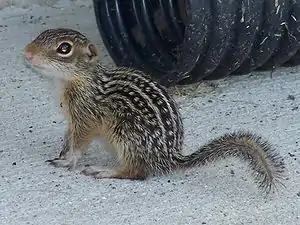 |
- 1 2 3 4 5 6 7 8 9 10 Petrella, S. (1999), Spermophilus Tridecemlineatus, http://animaldiversity.ummz.umich.edu/accounts/Spermophilus_tridecemlineatus/, retrieved October 5, 2012
- ↑ Dolbeer, R. (2005), Thirteen Lined Ground Squirrel and Thier Control, http://icwdm.org/handbook/rodents/13linedgroundsquirrel.asp, retrieved October 5, 2012
Eastern Chipmunk
| Tamias striatus (Eastern Chipmunk) | |
|---|---|
|
Family: Sciuridae (Squirrel)
Size: Total Length: 8.5-11.2 inches (215-285mm)
Tail Length: 2.8-4 inches (72-101mm) Weight: 2.8-5.3 oz. (80-150g)Description: 5 black stripes over red-brown, white, and grey stripes on back. Cream belly, white “eyeliner” stripes, 4 toes on front paws & 5 toes on back paws,[1] red-brown tail brown on tip
[2]
Similar Species: The Least Chipmunk (Tamias minimus) has similar striping patterns and toes, but is quite a bit smaller than the Eastern Chipmunk.
Range: The Eastern Chipmunk ranges from Eastern and Central United States (as far south as Louisiana and Florida) and Southeastern Canada, including Nova Scotia.
Habitat: Eastern Chipmunks live in burrows in deciduous forest or woodland edge, but they are also able to survive in urban environments
.[3] The home territory of an Eastern Chipmunk is usually less than 100 yards.
Diet: The Eastern Chipmunk eats nuts, acorns, seeds, mushrooms, corn, and sometimes berries, slugs, and snails. They collect up to 8 pounds of food for eating in winter.
Activity: Chipmunks run from burrow to collect food. They stuff and carry food in cheek pouches, as well as soil when digging burrows.[3] They are diurnal and hibernate.
Reproduction: Chipmunks call for mating season is a short “chip, chip, chip.” Mating is in March and again the latter half of June–July. Females may bite dominant male as form of rejection. Gestation is 31-32 days, and litters average 4-5. The babies are furless at birth and open eyes after the first month.
Lifespan: Eastern Chipmunks live 1-3 years, and up to 8 years in captivity.
Notes: They wake from hibernation and torpor to eat some and then return to sleep. (Torpor is an advanced stage of hibernation where about 75% of the chipmunk’s functions cease. This decreases energy usage, but can cause temporary brain damage.[3]) |
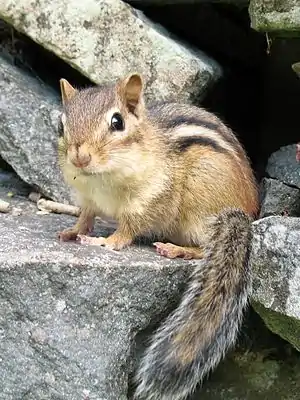 Eastern Chipmunk |
- ↑ Anderson, R.; Stephens, J. (2002), "Tamias striatus", Animal Diversity Web, http://animaldiversity.ummz.umich.edu/accounts/Tamias_striatus
- ↑ Whitaker, J.O (1980), A.A.Knopf, ed., Eastern Chipmunk (Tamias striatus)
- 1 2 3 Snyder, D. P. (1982), "Tamias striatus", Mammalian Species 168: 1–8, http://www.science.smith.edu/msi/
�
Least Chipmunk
| Tamias Minimus (Least Chipmunk) | |
|---|---|
|
Family: Sciuridae
Size: Range mass: 1.48oz-1.87oz (42g-53g)
Range length: 7.28in-8.74in (185mm-222mm) Range length of tail: 81mm-95mmDescription: The least chipmunk is the smallest of all the chipmunks. In some of the chipmunk population the female are bigger than the male. They have three dark and two light stripes on the face, with five dark and four light stripes along the sides which the middle strip runs all the way to the tail. Their fur colors are orangish-brown and grayish-white. The tail is long and bushy with a pale brown color to it.
Habitat: They live throughout North America from the Rocky Mountain regions to the western Great Plains. They are also found throughout central and western Canada, and in the states of Wisconsin, Minnesota, and Michigan. They prefer more open areas like forest edges and the openings. Some common places are near rock cliffs, river bluffs and open pine stands. The least chipmunk is the most widespread North American chipmunk, both in their geographic range and habitats (Harris, 1999).
Diet: The least chipmunks eat a variety of food which their diet consist of seeds, nuts, berries, fruits, grasses, fungi, snails, insects and possibly some small birds or mammals (Schlimme, 2000). These chipmunks spend most of their time from April through October foraging. Their cheek pouches allow them to carry food items back to their nests and are either eaten or store. They feed on ground, in shrubs or up in the trees and store food underground to use during winter (Harris, 1999).
Activity: When it’s cold the least chipmunks will climb on trees to keep themselves warm in the sun. They are adept climbers and some of them will make nest high above grounds where their nest are built seasonally. These least chipmunks are most active between the month of April and October. For the summer, their nest will be made from leaves and bark that are in rotting logs and tree cavities. As the winter, their nest will be underground burrows which consist of dried grass, bark, fur, feathers and soft vegetation. Hibernation for the least chipmunks is not as deep as compare to ground squirrels (Schlimme, 2000). Hibernation occurs from October to April and the male enter hibernation first (Harris, 1999). During these winter months and season they often awake to snack on stored food. They are not social except during mating season and during the time they are rearing young. But, when provisioned by humans then they are remarkably tolerant of conspecifics (Schlimme, 2000).
Reproduction: The males come out from hibernation before the females do and starts to get involve in competition for mates. Individual are sexually mature by 10 months. The mating season starts in April when females begin to come out of hibernation. Gestation usually last about 28-30 days for the least chipmunks (Harris, 1999). Litter size varies between 2 to 6 young and during a breeding season normally there is only a single litter of off springs but are capable of a second litter if the first one is lost. Young are born from April through May and will appear above ground around June to early July (Harris, 1999). Newborns are naked with a pink color, are 50 mm in length and average about 2.25 g. After the 28th days, their eyes will open and fur will not be fully grown until by the 40th day. Some may move the newborn to tree nest after they begin to activity out of the nest (Harris, 1999). As for lactation it’ll last about 60 days and the newborns will be with their mother for up to six weeks or more. The female will choose their nests for nursery while still pregnant. They are often lines with grass and usually located in stumps, under logs, in brush piles, or even rock piles. The location or position of the chosen nest for nursery will be protected from rainfall and runoff for the health and comfort of the newborns after birth. The role of males in the care for off springs is not certain but some indications are that males may help defend the home range of female with off springs, help maintain the nursery nest, and also bring food. (Schlimme, 2000).
Lifespan: The lifespan of these animals has not been reported but are known to be shorter than the Eastern chipmunks, which can live up to 11 years (Schlimme, 2000). |
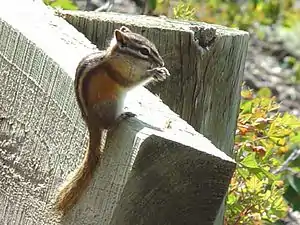 |
Red Squirrel
| Sciurus vulgaris (Red Squirrel) | |
|---|---|
|
Family: Squirrel
Size: Total length: 7.5-9 Inches (19-23 cm)
Tail length: 6-8 Inches (15-20 cm) Weight: 8.8-12 oz (250-340 g) [1]Description: Smallest squirrel in North America besides the flying squirrel. They are brownish-red in color with a white underbody and a black stripe to separate the two colors. Tail is also brownish-red in color, but has grey with white flecks underneath. Have prominent white eye ring.[2]
Similar Species: In addition to its very small size, the red squirrel has a reddish coat and a white eye ring that set it apart from other squirrels. They also have distinguished ear tufts [2]
Range: The red squirrel ranges across northern North America. They are found as far north as Alaska and across Canada. The squirrel is found all the way into northern Georgia, Arizona, and New Mexico.[3]
Habitat: This species prefers coniferous and mixed forests. It can also be found in hedgerows and deciduous forests. They prefer to nest in tree cavities, but also constructs leaf nests and uses ground burrows. The main factor of the squirrels habitat is the amount of food available.[4]
Diet: The red squirrel is omnivorous, but is primarily herbivorous. Their diet consists of seeds, conifer cones, nuts, fruits while occasionally feeding on invertebrates and small vertebrates.[3]
Activity: A diurnal animal that is active throughout the year. They are usually active the two hours after sunrise and before sunset for the purpose of feeding or social activity. Young squirrels tend be more active during the day for feeding. Red squirrels can be active at night, but it is usually caused by weather conditions. In addition, during the fall season there is a heavier focus on feeding which causes the squirrels to be more active.[4]
Reproduction: Red squirrels are sexually mature around one year old. Breeding season is from February to midsummer. Females are in estrus for less than a day, but may be solicited by several males. This can lead to breeding chases for several hours. Females usually have one litter a year, but occasionally have two litters. They will have 3-5 young per litter after a 35 day gestation period. The young are nursed for about 45 days and then leave the nest. They may remain with their mother after that for another several weeks or a month before going out on their own.[2]
Lifespan: Average life expectancy is about three years.[2] They have been known to live as long as 9 years in some cases. Predation can greatly impact the life expectancy of red squirrels in a range.[4]
Notes: insert notes |
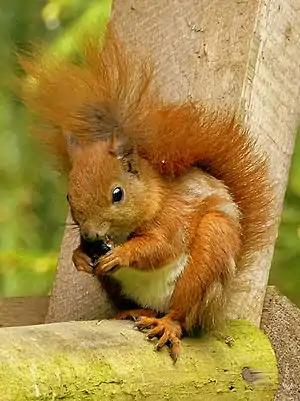 Red Squirrel |
- ↑ "North American Mammals", Smithsonian-National Museum of Natural, http://www.mnh.si.edu/mna/image_info.cfm?species_id=400, retrieved October 4, 2012
- 1 2 3 4 Koprowski, John, "The Natural History of the Mount Graham Red Squirrel Geographical", University of Arizona, http://www.ag.arizona.edu/research/redsquirrel/mgrs-nathistory.html, retrieved October 5, 2012
- 1 2 Layne, James (1954), "The Biology of the Red Squirrel in Central New York", Ecological Monographs, http://www.jstor.org/stable/10.2307/1948465, retrieved October 3, 2012
- 1 2 3 Linzey, A.V. (2008), "Tamiasciurus hudsonicus", IUCN Red List of Threatened Species, http://www.iucnredlist.org/details/42587/0, retrieved October 4, 2012
Eastern Fox Squirrel
| Sciurus niger (Eastern Fox Squirrel) | |
|---|---|
|
Family: Sciuridae
Size: The length of an eastern fox squirrel 17-27 inches (431.8-685.8mm) with a tail length of 10 inches long.[1] It weighs from 1-2 pounds (.45-.91kg)
[2]
Description: Eastern fox squirrel is a pretty large size squirrel with a long furry tail. The colors of their fur are black and silver-grey but mostly seen in reddish-brown. The belly is lighter colored in reddish-orange bellies and their nose, ears, and teeth are colored white. This species likes to sit on an upright position when peaking, eating, and observing. Eastern fox squirrels can also climb trees very well because of its sharp claws and masculine body.[3]
Similar Species: This specie is similar to eastern gray squirrels (Sciurus carolinesis) but has a bigger body.[3]
Range: These eastern fox squirrels live all over eastern and central United States, southern Canada, and northeastern Mexico.[1] As for Minnesota, they are sighted in all of Minnesota forests.
Habitat: Eastern fox squirrels only likes to live by wide and tall grasslands, forests (trees like oak trees and pine trees for nesting and food), and swamps.
Diet: All year long, they like to eat plants such as flowers and grasses. Eastern fox squirrels also like to eat fruits, nuts, and seeds. Not only that, they like to eat insects and rarely birds.[1]
[3]
Activity: Eastern fox squirrels do not hibernate during the winter or any other season. They like to sleep at night and become active in the morning and around the late afternoons. When they are awake, they climb trees, eat, look for food, and bury nuts underground for winter.
Reproduction: Eastern fox squirrels can mate all year long but most mate twice; usually during the spring and winter seasons. Male eastern fox squirrels start mating when they are 10-11 months old.[3] Pregnant females tend to give birth after 44 days and have about 1-6 babies but 1-3 only makes it alive. Female eastern fox squirrels can have up to two litters per year too. After 3 months of age, the babies can pretty much explore on their own lives.
[1]
Lifespan: For this specie, they are known to live up to 18 years of life but rarely make adulthood. Therefore, they usually live for 4-8 years in average.[1]
Notes: Eastern fox squirrels have a tail that is 40% as long as its body (from tip of nose to start of tail). Hunters hunt these species and other squirrels for food. They are usually hunted during the early fall seasons in state forests throughout Minnesota. |
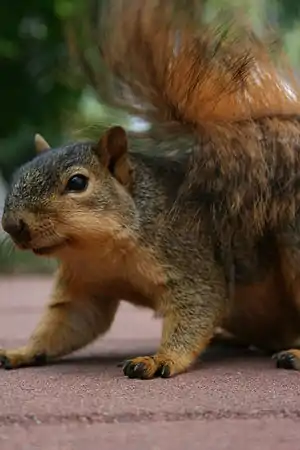 Eastern Fox Squirrel |
- 1 2 3 4 5 Fahey, Bridget, Fox Squirrel, http://www.biokids.umich.edu/critters/Sciurus_niger/, retrieved October 7, 2012
- ↑ Mason, Jim (2003), Fox Squirrel, http://www.gpnc.org/fox.htm, retrieved October 7, 2012
- 1 2 3 4 Garst, Warren (1922), Eastern fox squirrel standing on sand, http://digitool.library.colostate.edu/R/?func=dbin-jump-full&object_id=132848, retrieved October 7, 2012
Eastern Gray Squirrel
| Sciuris carolinensis (Eastern Grey Squirrel) | |
|---|---|
|
Family: Sciuridae
Size: Weight is usually 11.9-26.4 oz (338-750g). Length is 15-20.7 in. (380-525mm).
Description: Medium sized tree squirrel. No differences in size or color between sexes. Back of squirrel ranges from grey to cinnamon color. Front is light grey.[1]
Similar Species: Most differentiable feature between other similar squirrels is its long bushy tail.[2]
Range: Ranges from just west of Mississippi River through eastern states of the United States and up into Canada. Also live in Italy, Scotland, England and Ireland.
Habitat: Large woodlands with trees that produce winter storage such as acorns or walnuts.
Diet: Mainly nuts, buds, and flowers. Will eat farm crops such as corn or wheat, especially during winter. May also eat frogs, eggs, and insects.
Activity: The eastern grey squirrel does not hibernate. It is most active in summer 2 hours after sunrise and 2-5 hours before sunset to avoid overheating in the sun.[1]
Reproduction: There are 2 breeding seasons; one in first 2 months of the year, second in the middle 2 months of year. Gestation is 40 days. Many males may mate with one female. Once mated, the male has no role in rearing offspring. Average litter size of 3. Female will generally give birth to cavity prepared in tree. Newborn have no fur and develop the fur by 4 weeks. At 12 weeks, the young will be adult size and independent.
Lifespan: Average of 6 or less years[2]
Notes: The eastern grey squirrel was an important source of food for both the colonists and Native Americans and is still eaten by some people today. Squirrels can be a household pest by getting into bird feeders and can be destructive to property. Squirrels will either live permanently in a hollowed out tree or build a temporary nest made of twigs and leaves in the notch of tree branches. The eastern grey squirrel is hunted by many animals including hawks, coyotes, bobcats, and other carnivores. They are hard to catch because of their quickness and will produce a shriek to warn others of danger when a predator is near. They will eat almost anything including nuts, berries, field crops, and have even been known to be cannibalistic. They primarily live in large areas of heavily wooded areas. Communication between squirrels is translated through twitches and posture. The sense of smell is important to the eastern grey squirrel, allowing them to sense stress and the reproductive state of other squirrels. The eastern grey squirrel is important to its ecosystem, being known for spreading seeds of multiple beneficial plants. They are also the prey to many carnivores and prey on nuts and small animals as well.[1] |
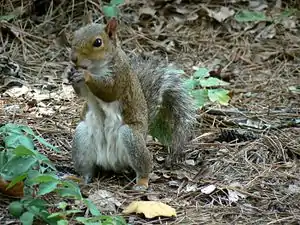 Eastern Gray Squirrel, Sciuris carolinensis |
- 1 2 3 Lawniczak , M. (2002), Animal diversity webe, http://animaldiversity.ummz.umich.edu/site/accounts/information/Sciurus_carolinensis.html, retrieved October 1, 2012
- 1 2 Hamilton , H. (1990), Hinterland, http://www.hww.ca/en/species/mammals/eastern-grey-squirrel.html, retrieved October 1, 2012
Northern Flying Squirrel
| Glaucomys sabrinus (Northern Flying Squirrel) | |
|---|---|
|
Family: Sciuridae
Size: Total Length: 10.24 in. (260 mm.). Tail Length: 8.19 in. (208 mm.).[1]
Weight: 2-3 oz. (56.7-85.05 g.) [2]
Description: The Northern Flying Squirrel has dense fur, olive-brown above and white below.[1]
It also has large brown eyes. Its tail is uniformly gray with a dark tip.[2] The tail is also flat for aerial control. The Northern Flying Squirrel has a membrane, called a patagium, which stretches from the front to the hind limbs.[3]Similar Species: The Northern Flying Squirrel is similar in appearance to the Southern Flying Squirrel, but larger and more robust. The Southern Flying Squirrel has a tail that is paler below and has a darker tip than The Northern Flying Squirrel.[1]
Range: Continuous across North America through central Canada.[1]
Habitat: Northern Flying Squirrels inhabit cool and moist forests near swamps or streams. Mixed coniferous-deciduous forests are ideal habitats for the species.[1]
In addition, they can be found to nest in tree hollows or leaf nests.[2]
Activity: They have a nocturnal activity pattern in the late summer, leaving the nest shortly after sundown and returning within two hours. They do not hibernate, remaining active during the winter months.[1]
Reproduction: Mates in late March through May. Gestation period of 37-42 days. Typical litter size of 2-4 (2-3 litters per year). Newborns weigh .18 oz. (5-6 g.) and are 2.76 in. (70mm) in length. Weaned at 2 months.[1]
Lifespan: 4 years in the wild. 13 years in captivity.[5]
Notes: The Northern Flying Squirrel has a long tail, up to 80% of its body length. It has no evident sexual dimorphism. Common predators include Barn Owls (Tylo alba), Great Horned Owls (Bubo virginianus), Red-tailed Hawks (Butao jamaicensis), and House Cats (Felis catus). Female Northern Flying Squirrels raise the young, with no help from male. Northern Flying Squirrels are social and often share nests during the winter. The Northern Flying Squirrel actually does not fly; it glides with glide lengths averages of 16.6 ft. (19.7 m.). They also help disperse conifer seeds. The Northern Flying Squirrel is usually clumsy on the ground and will occasionally get its patagium tangled in barbed wire and die.[1] |
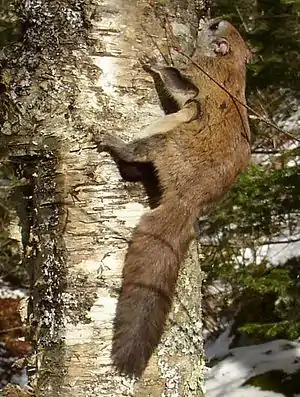 Northern Flying Squirrel Glaucomys sabrinus |
- 1 2 3 4 5 6 7 8 Wells-Gosling, Heaney, N., L.R. (1984), Glaucomys sabrinus, pp. 1–8
- 1 2 3 Minnesota Department of Natural Resources (2012), Glaucomys sabrinus
- ↑ Smithsonian National Museum of Natural History (2012), Glaucomys sabrinus
- ↑ Riebe, j. (2004), Glaucomys sabrinus
- 1 2 Malamuth, Mulheisen, E., M. (1999)
Southern Flying Squirrel
| Glaucomys volans (Southern Flying Squirrel) | |
|---|---|
|
Family: Sciuridae[1]
Size: Length: 8.3 to 10.1 inches (21.1 to 25.7 cm)
Tail Length: 3.1 to 4.7 inches (7.9 to 12 cm) Weight: 2.3 ounces (65.2 grams)[1]Description: Grayish-brown coat on the top of its body with a creamy white underside, large eyes that help the species see at night, gliding membrane that is a flap of loose skin from its wrist to its ankle that gives it the ability to glide through the air.[1][2]
Similar Species: Similar in characteristics to its cousin, the tree squirrel, gliding membrane is their differentiating trait.[2]
Range: Every state east of Texas including Minnesota, north to Quebec and Nova Scotia Canada and as far south as northwestern Mexico to Honduras.[3]
Habitat: In woodlands that are both conifer and deciduous forests and in suburbs preferring trees such as maple, hickory, oak, popular, and beech for their seeds and uses old woodpecker holes or a natural cavity as their nest sites.[1]
Diet: Omnivores consuming nuts, acorns, seeds, berries, fruit, moths, junbugs, eggs, young birds, young mice, fungus, bark, and leaf buds.[1][4]
Activity: Nocturnal gliding to avoid predators, often spotted in pairs or during winter hibernation have been found in groups upward to 20 in one den.[1]
Reproduction: In the northern locations births peak in April–May and late summer and in the southern locations late February–March and September–October, females have two liters per year and those liters consist of 2 to 3 young per liter but can reach as high as 6 with a gestation period of 40 days.[1][3]
Lifespan: 5 to 6 years within the wild 10 years within captivity, but most Southern Flying Squirrels probably die in their first year.[1]
Notes: Despite being a nocturnal squirrel, an animal not typically thought to be a pet, Southern Flying Squirrels have records dating back to 1606 and later of them becoming domesticated and described as easily tamed. People have domesticated this species and have made them into family pets and there are websites dedicated to informing and educating individuals on ownership and proper care like the National Flying Squirrel Association website.
The name of the species can me misunderstood if taken literally because in fact the Squirrels do not fly like a bird or other winged animals, they glide. Jumping from tree to tree or other structures and extending the membrane connected to their arms and legs allow the species to glide through the air giving them the ability to travel through the air with great control. Southern Flying Squirrels can make 90 degree turns while in flight and the maximum glide is up to 262 feet (80 meters). They may not be able to fly like a bird but the capabilities they do have maneuvering through the air are very impressive and fascinating. While flying around within their natural habitats these squirrels consume fungi and the spores that are left behind in their feces is thought to be importance in the growth and sustainability of trees, trees that they may actually have helped to produce by scattering hardwood seeds.[1][2] |
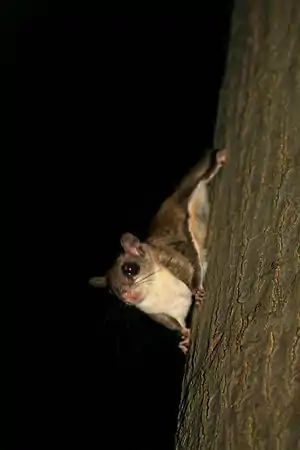 Southern Flying Squirrel |
- 1 2 3 4 5 6 7 8 9 Fox, David; Mulheisen, Michael (1999), "Glaucomys volans", Animal Diversity Web, http://animaldiversity.ummz.umich.edu/accounts/Glaucomys_volans/, retrieved October 11, 2012
- 1 2 3 National Flying Squirrel Association, http://www.nfsa.us/home, retrieved October 11, 2012)
- 1 2 Linzey, A.V.; NatureServe (Hammerson, G.) (2008), "Glaucomys volans", IUCN 2012. IUCN Red List of Threatened Species (Version 2012.1), http://www.iucnredlist.org/, retrieved October 11, 2012
- ↑ Smithsonian National Museum of Natural History, http://www.mnh.si.edu/mna/image_info.cfm?species_id=106, retrieved October 11, 2012)
Pocket Gophers
Plains Pocket Gopher
| Geomys bursarius (Plains Pocket Gopher) | |
|---|---|
|
Family: Geomyidae
Size: Total length: Average- 9 Inches (236 mm)
Tail length: Average- 3 Inches (65 mm) Weight: Males = 6-7 oz (180-200 g) Females = 4-6 oz (120-160 g) [1]Description: Plains pocket gophers are medium to small sized, dark brown gophers. They have fur-lined cheek pouches with a thick body and tiny bead-like eyes. Their front claws are long and curved for digging with smaller claws on the hind feet.[1]
Similar Species: The eastern mole is similar, but creates a mound with a cone shape instead of the kidney shape a plains pocket gopher creates.[1]
Range: The plains pocket gopher is from the Great Plains of North America. They have been found in southern Manitoba into the Midwest from eastern North Dakota to Indiana. Their range also extends south into New Mexico and Texas.[2]
Habitat: This species typically likes to be in sandy soils for easier digging while clay type soils are usually avoided. Gophers live primarily solitary lives in burrows and tunnels and seldom travel far over land. They burrow at shallow depths usually in search of food.[1]
Diet: The plains pocket gopher is herbivorous and consists mostly of grasses, forbs, and roots. Most common grasses include brome, oats, and bluegrass. Some studies have indicated that gophers prefer forbs over grasses. All of the gopher’s necessary water is obtained from their food.[3]
Activity: The plains pocket gopher is active day and night, but primarily around the times of sunrise and sunset. This is when they do a great deal of digging. Gophers live within loose, social ‘colonies,’ but are primarily solitary with small home ranges. They stay within burrows and tunnels most of the time. Tunnels between neighbors are not connected.[2]
Reproduction: Mating occurs during the spring. The gestation period is about 30 days. Females give birth to one litter of 4-5 young a year in late spring. When the young are ready to be weaned, the mother evicts them from the burrow. Gophers are sexually mature at 12 months of age.[2]
Lifespan: The average life expectancy for this species is 5 years, but some have been known to live for 10 or 11 years.[4] |
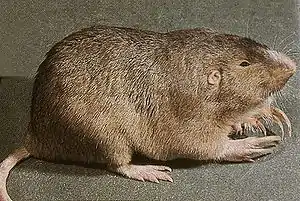 Plains Pocket Gopher |
- 1 2 3 4 Schmidly, David (1994), [Retrieved from http://www.nsrl.ttu.edu/tmot1/geomburs.htm "Plains Pocket Gopher"], The Mammals of Texas-Online Edition, Retrieved from http://www.nsrl.ttu.edu/tmot1/geomburs.htm, retrieved October 3, 2012
- 1 2 3 Linzey, A.V. (2008), [Retrieved from http://www.iucnredlist.org/details/42588/0 "Geomys bursarius"], IUCN Red list of Threatened Species, Retrieved from http://www.iucnredlist.org/details/42588/0, retrieved October 2, 2012
- ↑ Behrend, A; Tester, J (1988), "Feeding ecology of the Plains Pocket Gopher in East Central Minnesota", University of Minnesota, http://www.lter.umn.edu/biblio/fulltext/t1011.pdf, retrieved October 3, 2012
- ↑ Miller, Richard (1964), "Ecology and Distrubition of Pocket Gophers(Geomyidae)in Colorado", Ecological Society of America, http://www.jstor.org.ezp1.lib.umn.edu/stable/info/1933839, retrieved October 4, 2012
Northern Pocket Gopher
| Thomomys Talpoides (Northern Pocket Gopher) | |
|---|---|
|
Family: Geomyidae[1]
Size: The average adult northern pocket gopher weighs 2.75-5 ounces (or 60-160 grams). Their total body length ranges from 6.5-9 inches (or 165-260 mm and their tail length vary from 1.6-2.9 inches (or 40-74 mm).[2]
Description: Northern pocket gophers have a tubed-shaped body, small ears and eyes, and short smooth fur that is brownish to tan. The mammal also displays a short, hairless tail and dark patches behind the ears.[3]
Similar Species: Darker fur color, smaller eyes and black patches of hair around the ears distinguish it from similar species such as the Idaho pocket gopher.[2]
Range: This species has the greatest range of any pocket gopher in North America, ranging from Alberta to Saskatchewan, south to northern Arizona and New Mexico, and from Washington east to Minnesota.[2]
Habitat: Northern pocket gophers occupy a great variety of habitats. They are commonly found in deep soils along streams and cultivated fields. They can also be found in rocky soils and clay, in bushy areas, and even in Alpine tundra.[2]
Diet: Their diet consists of roots of forbs, cacti and grasses.[3]
Activity: Northern gophers are often found digging, constructing elaborate networks of tunnels. They are very territorial and aggressive, except during mating season. There are brief periods of inactivity during the summer and winter but do not truly hibernate at any time.[2]
Reproduction: Female northern pocket gophers breed once a year. Mating periods vary depending on weather and latitude, but often occur from March to mid-June. A female produces a litter of 4-7 young after a gestation period of 19-20 months.[3]
Lifespan: The species can live up to 6 years in captivity. In the wild, they are expected to live between 18-24 months. Every 5 years there is a total population replacement. Similar to other mammals, the females live longer than males, so there are times in the late summer where the majority of the species population is female.[3]
Notes: The northern pocket gopher gets its name from their fur-lined cheek pouches, or pockets, which are used for carrying food. Their whiskers and tail serve as sensory mechanisms to assist them in navigating in the dark.[4]
Another interesting note is that pocket gophers are rarely observed above ground. And when they are above ground, they never venture very far away from their burrow entrance.[1] |
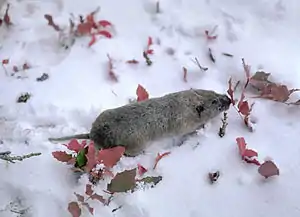 Northern Pocket Gopher |
References
- 1 2 Linzey, A.V. (2008), Thomomys talpoides, http://www.iucnredlist.org/details/42597/0, retrieved (October 4, 2012)
- 1 2 3 4 5 McMahon, J.A. (1999), Smithsonian Book of North American Mammals, http://animaldiversity.ummz.umich.edu/accounts/Thomomys_talpoides/#physical_description, retrieved (October 11, 2012)
- 1 2 3 4 Streubel, D. (2000), Thomomys talpoides, http://imnh.isu.edu/digitalatlas/bio/mammal/Rod/Gophers/npogo/npgo.htm, retrieved (October 11, 2012)
- ↑ Link, R (n.d.), Living with wildlife in the pacific northwest, http://wdfw.wa.gov/living/gophers.html, retrieved (October 11, 2012)
Rats & Mice
Southern Bog Lemming
| Synoptomys Cooperi (Southern Bog Lemming) | |
|---|---|
|
Family: Lemming
Size: The average length of the Southern Bog Lemming is 3.7-6.06in (94-154mm). The average length of its tail is .51-.94in (13-24 mm). And, its average weight is .75oz (21.4-50g).[1]
Description: This species is small with a very short tail, minimal length, and small eyes. The head is larger compared to its body size. The hair color ranges from a light chestnut to a darker shade of brown. .[2]
Similar Species: The Southern Bog Lemming is the smallest when it comes to body size in the mice family. The sexes also do not make a significant difference when it comes to size.[1]
Range: This specie’s general range of population is in the Northeastern part of the United States and South Eastern parts of Canada. In Minnesota in particular, the population thrives in the North Western part of the state.[3]
Habitat: The Southern Bog Lemming's habitat ranges from wet grasslands, forests, to grassy wetlands. It's burrow holes are typically 6-12 inches deep and its home range varies from 1/4 of an acre.[4]
Diet: This species diet consists of plants, leaves, stems, and seeds. It is also known to eat small fruits.[2]
Activity: The Southern Bog Lemming is active day and night throughout the entire year. They tend to be independent creatures that travel alone.[5]
Reproduction: This species breeds year round, but its reproduction thrives between the months of April–September. Gestation lasts between 21-23 days and the litter size once born is about 8-11. The Southern Bog Lemming reaches sexual maturity 60 days after birth.[4]
Lifespan: It has a lifespan of about 2.5 years.[5]
Notes: The Southern Bog Lemming could be the mouse you catch in your house. It breeds year round and says goodbye to their young in just 60 days. They are very small with a short tail and small eyes. Their color ranges from browns, but typically they will be a chestnut or darker brown. Since the Southern Bog Lemming’s population thrives in the Northwestern part of Minnesota, counties such as Marshall, Clearwater, and Lake of the Woods have a significantly larger population than Minneapolis would. This mouse has no significant threats and it is on the “least concerned” list for extinction. |
 Southern Bog Lemming |
- 1 2 Linzey, Alicia (1983), Synoptomys Cooperi, American Society of Mammalogists, pp. 1–5
- 1 2 Linzey, A.V. (2008), Synaptomy Cooperi, IUCN Red List of Threatened Species, p. 1
- ↑ Roset, Robert (2012), Minor species as the dominant rodents in an Oldfield, American Midland Naturalist, pp. 1–8
- 1 2 Osbourne, Joseph (2005), Effects of Habitat on small-mammal diversity and abundance in West Virginia, Wildlife Society Bulletin, pp. 814–822
- 1 2 Bien, Walter; Spotilafirst2=James (2007), The distribution of small mammals at the Warren Grove Gunnery Range with special emphasis on Southern Bog Lemming and Meadow Jumping Mice, New Jersey Academy of Science, pp. 9–12
Northern Bog Lemming
| Synaptomys borealis (Northern Bog Lemming) | |
|---|---|
|
Family: Cricetidae [1]
Size: Average length overall: 4.7 inches (120 mm). Tail length: .8-.9 inches (21 to 23 mm). Weight: 0.77-.88 ounces (22 to 25 grams) [1]
Description: The northern bog lemming has reddish-brown fur that fades into gray on the under belly. It has noticeable ears that extend longer than the fur and has a very short tail.[1]
Similar Species: Similar in appearance to mice and voles but has a much shorter tail. The only way to distinguish the northern bog lemming from the southern bog lemming is by dental and skull characteristics.[1][2]
Range: Northern bog lemming can be found from Kansas, to Canada, and throughout northern states from Washington to Maine. In Minnesota they have been found in Lake of the Woods, Roseau, Koochiching, and Itasca counties.[2]
Habitat: Areas where moisture is high and grasses are present for food and shelter. They can be found in grass meadows within forests, wet meadows, bogs, tundra, and recently burned forest areas and typically inhabit an area less than one acre.[3]
Diet: The northern bog lemming consumes sedges, grasses, snails, slugs, and other invertebrates.[1][4]
Activity: They are nocturnal and diurnal. They create runways shared with other species by marking them with droppings. They remain active year around but spend summer months within burrows to avoid predators.[1][4][5]
Reproduction: The breeding season occurs from May to August. With a 3 week gestation period they have 2-3 litters per season with 2-8 offspring per litter. They are able to reproduce at 5 to 6 weeks of age.[2][4]
Lifespan: The average lifespan of a similar species, the Southern Bog Lemming is 2.4 years; though the lifespan of this northern variant remains unknown.[6]
Notes: Very little is actually recorded and known of this species which is hard to believe due to their reproduction habits and abilities. The northern bog lemming can have 2 to 3 litters in only a 4 month breeding season which seems like an impossible number, but the day after the females give birth they can breed again. Within the average 1 acre habitat, communities can range up to 36 lemmings. The extremely rapid breeding habits coupled with the low population density leads researchers to believe that there is a high mortality rate in the first year. The Minnesota Department of Natural Resources has developed concern for the lemmings scarcity. A Minnesota plan, Tomorrow’s Habitat for Wild and Rare, has listed the northern bog lemming as a species in need of great conservation.[1][2] |
 Northern Bog Lemming (this is the Southern Bog Lemming) |
- 1 2 3 4 5 6 7 Northern Bog Lemming — Synaptomys borealis, http://fieldguide.mt.gov/detail_AMAFF17020.aspx, retrieved October 11, 2012)
- 1 2 3 4 Nordquist, Gerda, Northern Bog Lemming, http://www.dnr.state.mn.us/volunteer/novdec06/mp.html, retrieved October 11, 2012)
- ↑ Linzey, A.V.; NatureServe (Reichel, J.D. & Hammerson, G.)year=2008, "Synaptomys borealis", IUCN 2012. IUCN Red List of Threatened Species (Version 2012.1), http://www.iucnredlist.org/, retrieved October 11, 2012
- 1 2 3 Nicholas, Danielle (2001), "Synaptomys borealis", Animal Diversity Web, http://animaldiversity.ummz.umich.edu/accounts/Synaptomys_borealis/, retrieved October 11, 2012
- ↑ Smithsonian National Museum of Natural History, http://www.mnh.si.edu/mna/image_info.cfm?species_id=375, retrieved October 11, 2012)
- ↑ Saunders, D.A. (1988), "Adirondack Mammals", IUCN 2012. IUCN Red List of Threatened Species (State University of New York, College of Environmental Science and Forestry): 216, http://www.esf.edu/aec/adks/mammals/bog_lemming.htm, retrieved October 11, 2012
Southern Red-backed Vole
| Clethrionomys gapperi (Southern Red-backed Vole) | |
|---|---|
|
Family: Cricetidae
Size: Length: 4.57-6.77 in (116-172 mm)
Weight: 0.21-1.48 oz (6-42 g)
Description: The Southern red-backed vole has a broad reddish stripe from its forehead to its bottom, with a grayish nose and sides of the head, and a whitish, creamy belly. Its tail is bicolor, with dark brown or black and whitish or gray at the end of the tail. It has a stocky build, short ears, and small eyes.[1]
Similar Species: Its tail is more slender and has less hair than the Northern red-backed vole. Its back is also brighter and has smaller ears than the Northern red-backed vole.[2][3]
Range: It can be found in the Rocky Mountains south to southwestern New Mexico and Arizona, the Northern Great Plains to Iowa, and the Appalachian mountains to northern Georgia.
Habitat: The Southern red-backed vole inhabits moist coniferous, deciduous, and mixed forests with stumps and logs for ground cover. Some voles are found in muskegs, sedge marshes, and bogs. It nests under logs, stumps, and roots, but will use the burrows of moles and other small mammals instead of making its own nest.[3]
Diet: It is an herbivore with a diet of plants, seeds, nuts, berries, mosses, lichens, ferns, fungi, and arthropods. Southern red-backed voles have also been known to eat insects.
Activity: The Southern red-backed vole mates with more than one vole of the opposite sex, and generally does not form colonies.[3] It is active day and night, but it is more nocturnal than diurnal.[3][4]
Reproduction: The breeding season lasts about 7 months in the wild, from late winter to late fall, and gestation is 17-19 days. Litter size ranges from 2-8 young, with 1 to 6 litters per year. In 2 to 4 months young are sexually matured .[3][5]
Lifespan: Most live 10-12 months in the wild, although they have been reported to live up to 20 months. Few survive two winters.[3] |
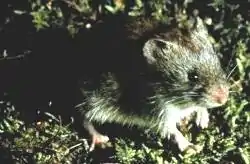 Southern Red-backed Vole, Clethrionomys gapperi |
- ↑ Hazard, E. B. (1982), The Mammals of Minnesota, Minneapolis, MN: The University of Minnesota Press, pp. 90–91
- ↑ Reid, F. A. (2006), Mammals of North America, Boston, NY: Houghton Mifflin Company, pp. 308–309
- 1 2 3 4 5 6 Merritt, J. F. (1981), "Clethrionomys gapperi", Mammalian Species (146): 1–9, http://www.science.smith.edu/msi/, retrieved September 23, 2012
- ↑ Linzey, A. V.; NatureServe (2010), "Canis lupus", IUCN Red List of Threatened Species (Version 2012.1), http://www.iucnredlist.org, retrieved September 28, 2012
- ↑ NatureServe (2012), "Clethrionomys gapperi", NatureServe Explorer: An online encyclopedia of life (Version 7.1), http://www.natureserve.org/explorer, retrieved September 28, 2012
Rock Vole
| Microtus chrotorrhinus (Rock Vole) | |
|---|---|
|
Family: Cricetidae
Size: Weight is 1.1-1.7 oz (30-40g). Length is 5.5-7.3 in. (140-185mm). Tail Length is 1.7-2.5in (42-64mm).
Description: Vole’s nose is orange-yellow hue. Fur is yellowish, grayish brown except on the stomach which is a silvery gray.
Similar Species: Vole’s nose is orange-yellow hue, differentiating it from any other vole.[1]
Range: Is found in northeast Canada down to northeastern Minnesota. Also found in South Carolina and Tenessee.
Habitat: Lives around rocks and boulders in coniferous forests near water and mosses they eat and other plants.
Diet: Fungi, fruits, and vegetation. Cuts pieces off and moves between rocks to eat.
Activity: Rock voles do not hibernate. They are active throughout both day and night, possibly eating more during the morning than any other time.[1]
Reproduction: Breeding season from March until October. 2-3 litters of an average 3-4 young each time. Gestation period is about 20 days.[1]
Lifespan: Average lifespan is less than one year.[2]
Notes: Rock voles, also known as Southern rock voles, are hard to assess as far as population numbers go. They are thought to be slowly declining in numbers due to multiple reasons. Optimal nesting sites for rock voles is near moving water, ferns, and mosses. The nests of rock voles are based around logs, boulders, and other protected places. They are known for living in the higher elevations in the Appalachians and the coniferous forests of Canada. They will use tunnels made by other burrowing animals underground. The primary competitors of rock voles are the red-blacked vole, shrews, the deer mouse, and deer. They also have to worry about parasites such as tapeworms, roundworms, fleas, mites, ticks, and fleas. Ski developments are having a negative impact on the populations of rock voles while logging seems to increase the population numbers of the rock vole population greatly. The best populations and habitats of rock voles are found in the northern range of North America, but there are also smaller populations in the eastern and southern range. The rock vole is not a highly populated specie but are so spread out throughout the continent and can adapt to many habitats so they are not at risk of extinction.[2] |
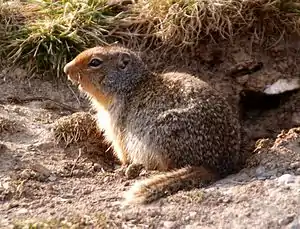 Rock Vole, Microtus chrotorrhinus |
- 1 2 3 Saunders, D. A. (1988), Rock vole (microtus chrotorrhinus miller), http://www.esf.edu/aec/adks/mammals/rock_vole.htm, retrieved October 1, 2012
- 1 2 Linzey, A. V. (2008), Microtus chrotorrhinus, http://www.iucnredlist.org/details/42626/0, retrieved October 1, 2012
Meadow Vole
| Microtus pennsylvanicus (Meadow Vole) | |
|---|---|
|
Family: Cricetidae
Size: Weighing on average 1.5 oz (48 g) the Meadow Vole is a small rodent that is around 5 to 7 inches long (128 to 195 mm) with a tail that is over 40% of their body size.[1]
Description: The back of the meadow vole is very dark brown and black colored with very course hairs. Their stomachs are a very light tan, white, or light brown color.[1]
Similar Species: Similar species to the Meadow Vole are Pine Voles and other types of voles. Their skulls are rather long and slightly angular making them different from other species. Also, the meadow vole is larger than the pine and other voles and also have longer tails. Voles are very good swimmers that can dig very well too.[1]
Range: Home to central North America, it is the largest mole population across the nation. The Meadow vole makes his home all the way across the country including Alaska and a small part of southern Canada.[1]
Habitat: Because the Meadow Vole is a good swimmer, you can find this species along rivers and lakes, grassy marshes and lowland fields. Meadow Voles can also be found in some fields but are mainly in meadows and wet areas. Flooded marshes and grasslands are another habitat these creatures can be seen.[1][2]
Diet: Not only are grasslands commonly the home for the Meadow Vole, fresh grass is often consumed by this critter as well. Besides grass, they tend to eat seeds, grains, sedges, herbs. Their vegetation changes with the season eating more grass in the summer and more grains in the winter. A vole will eat 60% of its body weight at a time.[1]
Activity: The Meadow Vole is nocturnal during the summer and winter months but is active all times of day during spring and fall. Females are very territorial and the only time that you will see two females together are if they are mother and daughter. Males will live a range of areas.[1]
Reproduction: Females may bare babies during any month of the year but most are born in spring and fall. Voles grow quickly, weaning off of their mothers in around 12 days after birth. Females can breed when they are only 28 days old but males are not ready until around day 35. On average, about five voles are born at a time.[1][2]
Lifespan: Live usually less than a year due to predators but can live up to around two years.[1]
Notes: When it comes to breeding, the mothers are very territorial. It has been observed that the meadow vole females to not like to let their young breed although they are mature enough to. The reason behind this is unknown. Also, they hardly make noise but when they do, they are using their vocals in a defensive situation not and offensive. They can also hear and smell really well which helps them out in the wild. Although they are small, meadow voles are small, they are very aggressive and will attack.[1] |
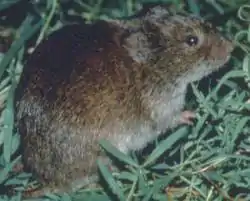 |
- 1 2 3 4 5 6 7 8 9 10 Neuburger, T. (1999), pennsylvanicus/ Microtus pennsylvanicus, http://animaldiversity.ummz.umich.edu/accounts/microtus pennsylvanicus/, retrieved October 5, 2012
- 1 2 Saunder, D. A. (1988), Meadow Vole, http://www.esf.edu/aec/adks/mammals/meadow_vole.htm, retrieved October 5, 2012
Prairie Vole
| Microtus Ochrogaster (Prairie Vole) | |
|---|---|
|
Family: Cricetidae
Size: The prairie vole has a total length of 5.7 inches (or 146 mm) and weighs 1-1.8 ounces (or 30-50 grams). Its tail has an average length of 1.3 inches (or 34mm).[1]
Description: The prairie vole is a medium-sized animal similar in appearance to a mouse. They have stocky, compact bodies with brownish-black fur. Some of the longer furs on their bodies have yellow tips, giving the species a grizzled appearance. In addition, the furs on their bellies often show a yellow cast.[2]
Similar Species: Though the prairie vole is similar in appearance to the meadow vole, yellow fur on their bellies serves as a distinguishing feature. In addition, the sides of the prairie vole are somewhat paler than the back and the tail has two distinct colors.[3]
Range: This species ranges throughout the prairie states of the United States and north toward southern provinces of Canada. They are also found in east-central Alberta, central Saskatchewan, and southern Manitoba through northern Oklahoma and Arkansas, Ohio, West Virginia, Kentucky, central Tennessee, and westernmost Virginia.[4]
Habitat: Prairie voles live in tall-grass prairies, often ones with very dry soil. They live in colonies, using burrows for protection in upland agricultural habitats. They will also inhabit herbaceous fields; grasslands, and even old agricultural lands.[4]
Diet: Prairie voles eat mostly vegetables, such as plants, seeds, bulbs and bar. They store much of this food for winter. They are also known to eat the flesh of other prairie voles.[2]
Activity: Prairie voles are active year round both day and night. Their peak activity occurs near dusk. They are more active during the day in the winter, and more active at night in the summer seasons.[4]
Reproduction: Their breeding habits are not entirely well known. It is thought they breed throughout the year, but primarily in the spring and summer seasons. Each female produces several litters per year of two to six children.[2]
Lifespan: Prairie voles rarely live longer than one or two years in the wild. In captivity, they may live up to 16 months.[3]
Notes: Prairie voles are one of very few monogamous mammals.[5] In addition to being monogamous, they are extremely loyal partners to their mates. Their behavior often suggests that they would rather spend time with their mates than with any other voles. They even avoid other voles of the opposite sex to focus on their mates. Similar to humans, prairie voles release the hormones oxytocin and vasopressin after mating. These hormones have been linked to pair bonding and may be the reason they bond with their first mate. Prairie voles also form family units, where both parents support their offspring as well as each other.[6] |
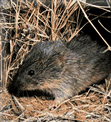 Prairie Vole |
References
- ↑ Hazard, E.B. (1982), The mammals of Minnesota, Minneapolis, Minnesota: University of Minnesota Press
- 1 2 3 , http://www.nsrl.ttu.edu/tmot1/microchr.htm, retrieved October 13, 2012
- 1 2 Stalling, D.T. (1999), Microtus ochrogaster, pp. 1–9
- 1 2 3 Linzey, A.V. (2008), Microtus ochrogaster IUCN Red List of Threatened Species, http://www.iucnredlist.org/details/42631/0, retrieved October 14, 2012
- ↑ Kettlewell, J. (2004), 'Fidelity gene' found in voles, http://news.bbc.co.uk/2/hi/science/nature/3812483.stm, retrieved October 14, 2012
- ↑ Young, L. (2004), "Reward mechanism involved in addiction likely regulates pair bonds between monogamous animals", Emory University Health Sciences Center, http://www.sensualism.com/love/addiction.html, retrieved October 14, 2012
Muskrat
| Ondatra zibethicus (Muskrat) | |
|---|---|
|
Family: Cricetidae
Size: The average length of the Muskrat is 15.75-27.5 inches (40- 70 cm) long, almost half of that makes up their tail. It weights between 2- 4 lbs (908-1816 g).[1] Muskrats are much larger than the other animals in their subfamily, which include the vole and the lemming.
Description: The Muskrat is a medium-sized semiaquatic rodent that is native to North America. They are covered with short, dense fur, which is medium to dark brown or black in color, with a lighter underside. As the muskrat ages, it turns partly gray in color. The fur has two layers, which helps protect them from the cold water. To aid them in swimming, they have a long tail covered with scales rather than hair. Their tails are slightly flattened from side to side which is a shape that is unique to them.[1]
Similar Species: The muskrat is the only species in genus Ondatra, but it is the largest species in the subfamily Arvicolinae, which includes 142 other species of rodents, mostly voles and lemmings. The muskrat’s distinguishing features from these other species is it’s overall coloration, it’s waterproof fur with chestnut to hazel sides and underbelly, it’s tail flattened vertically, and it’s furless hind feet that are partially webbed.[2]
Range: Muskrats are found over most of the United States and Canada and a small part of northern Mexico. They were also introduced to Europe in the beginning of the 20th century.
Habitat: Muskrats mostly inhabit wetlands, areas in or near saline and freshwater wetlands, rivers, lakes, or ponds. They are able to live alongside streams and slow-moving rivers and in waters that are deep enough not freeze at the bottom.[2]
Diet: The muskrat commonly eats the cattail, yellow water lily, and other aquatic vegetation. They do not store food for the winter, but sometimes eat the insides of their lodges. Plant materials make up 95% of their diet, and they also eat small animals such as freshwater mussels, frogs, crayfish, fish, and small turtles.[3]
Activity: Muskrats are most active at night or near dawn and dusk. Muskrats follow trails they make in swamps and ponds, and when the water freezes, they continue to follow their trails under ice. They normally live in groups consisting of a male and female and their young. In the spring, they often fight with other muskrats over territory and potential mates.
Reproduction: During the spring, muskrats often fight with each other over territory and potential mates. Many are injured or killed in these fights. Muskrat families build nests to protect themselves and their young from cold and predators. They are prolific breeders, where the females can have two to three litters a year of six to eight young each. Babies are born small and hairless, and weigh only about 22 grams. Young muskrats mature between 6 months to a year. The gestation period for muskrats is 22-30 days.[1]
Lifespan: The lifespan for a muskrat is 2-3 years old.[4]
Notes: The muskrats are sometimes referred to as “rats” in a general sense because they are medium-sized rodents with an adaptable lifestyle and omnivorous diet, but they are not, however, “true rats” because they do not belong in the genus Rattus.
American Indians have long considered the muskrat to be a very important animal. Some predict winter snowfall levels by observing the size and timing of muskrat lodge construction. Contrary to belief, though, the thickness of muskrat lodges does not indicate the severity of the coming winter. The muskrat’s underfur traps air, and prevents the skin of the muskrat from becoming wet while it is in the water. Musk glands are predominant beneath the skin on the lower abdomen of male muskrats. These two glands become swollen during the spring and produce a yellowish, musky smelling fluid. Thus, the name “muskrat”. With their webbed feet, muskrats can also swim at a speed up to 3 miles per hour and can even swim backwards.[5] Unlike the beaver, the muskrat does not store food for the winter. It needs to eat fresh plants each day, and sometimes it makes channels in the mud to get from its house to reach food under the ice. To stay warm in winter, groups of muskrats huddle together in their lodges.Muskrats have the ability to hold their breath underwater for a 12-17 minutes while searching for food. When food is scarce, female muskrats have been known to eat their young.[6] |
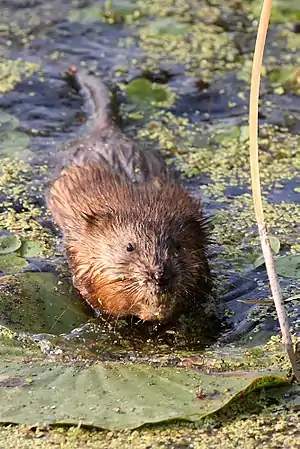 Muskrat |
- 1 2 3 Muskrat, http://www.holoweb.com/cannon/muskrat.htm, retrieved (October 13, 2012)
- 1 2 Ondatra zibethicus - Muskrat, http://www.borealforest.org/zoo/muskrat.htm, retrieved (October 13, 2012)
- ↑ Common Muskrat: Natural History Notebook., http://www.nature.ca/notebooks/english/muskrat.htm, retrieved (October 13, 2012)
- ↑ NatureWorks - Common Muskrat, http://www.nhptv.org/natureworks/muskrat.htm, retrieved (October 13, 2012)
- ↑ Muskrat, http://www.kaweahoaks.com/html/muskrat.html, retrieved (October 13, 2012)
- ↑ Minnesota Department of Natural Resources, http://www.dnr.state.mn.us/mammals/muskrat.html, retrieved (October 13, 2012)
Northern Grasshopper Mouse
| Onychomys leucogaster (Northern Grasshopper Mouse) | |
|---|---|
|
Family: Neotominae
Size: Ranging from 4.5-7.5 inches (12-19cm) in length overall, tail between 1-2 inches (3-6cm). Weighing roughly 1.8 ounces (52g) at maturity.[1][2]
Description: The northern grasshopper mouse is a bulkier rodent (though still quite small) with a greyish to pale brown fur on top and a white underbelly. Its tail is short and thick generally with a white tip.[1]
Similar Species: Besides a shorter tail and larger forefeet, the northern grasshopper mouse differs in that it’s primarily a carnivore and has adapted larger teeth to kill prey. Similar species eat mostly nuts seeds and only occasionally insects.[1][3]
Range: The northern grasshopper mouse inhabits a wide area. From a line beginning in northern Mexico through Texas and the western half of Minnesota into Manitoba, extending west to the coast. They tend to be territorial so population density is low.[2]
Habitat: This species does well in western prairies, plains, sparse pastures and deserts with minimal vegetation, commonly inhabiting the burrows of other animals. They have also adapted to more mountainous regions in many cases.[2]
[3]
Diet: Primarily carnivorous (70-90%), mostly insects - occasionally poisonous, reptiles, other mice, small birds and other creatures. Grasshopper mice will eat plants when other food is scarce and have been known to store seeds in preparation for winter survival.[2]
Activity: Primarily Nocturnal and active throughout the year, reduced during a full moon likely because of exposure to other predators, likewise during heavy rainfall because of difficulty hunting. Mated pairs defend their territory against other grasshopper mice and will bark or howl to ward off intruders.[2]
[4]
Reproduction: Gestation ranges from 32-38 days, litter sizes are from 1-6, In the wild grasshopper mice produce an average of three litters per year and up to 6 in a lab environment. The male and female rear their young together.[2][4]
Lifespan: Approximately three years.[4]
Notes: Because of its territorial nature the grasshopper mouse is sparsely populated over a wide area and adapts well to varied climates. Despite their ferocious nature, grasshopper mice are preyed upon by owls, coyotes, snakes and other predators and are easily displaced by human populations.[4] |
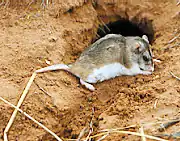 Northern Grasshopper Mouse |
- 1 2 3 McCarty, Richard (1978), "Onychomys Leucogaster", Mammalian Species 87: 1–6 (--or--, http://www.science.smith.edu/msi/pdf/i0076-3519-087-01-0001.pdf, retrieved (October 4, 2012)
- 1 2 3 4 5 6 "Onychomys Leucogaster", NatureServe, (2003), http://www.natureserve.org, retrieved (October 16, 2012)
- 1 2 Minnesota Department of Natural Resources, Lemmings, Mice Rats and Voles, http://www.dnr.state.mn.us/mammals/mice_voles_rats/index.html, retrieved (October 16, 2012)
- 1 2 3 4 The Worsley School ((2001)), Carnivorous Mice, http://www.worsleyschool.net/science/files/grasshopper/mouse.html, retrieved (October 16, 2012)
White-footed Mouse
| Peromyscus Leucopus (White Footed Mouse) | |
|---|---|
|
Family: Cricetidae.
Size: The total length of the White Footed Mouse is around 6.8 inches (173mm). The tail has a length of 3.1 inches (78mm) and their hind foot is around 0.83 inches (21mm). The weight of the mouse ranges from 0.03- 0.06 pounds (15-25g), with an average of 0.05 pounds (23g).[1]
Description: the general color of the back and sides is reddish or orange-ish. They have a dark brown stripe along the middle of the back from the head to tail. The throat, belly, and feet are white; the ears thin, sparsely furred, and prominent.
[2]
Similar Species: The White Footed Mouse is very similar to the deer mouse in size and color. It is hard to find distinguishable features between them.[2]
Range: They are found throughout eastern United States as well as throughout the plains states.
Habitat: They are most abundant in warm, dry forests and brush-lands at middle elevations. They build nests in places that are warm and dry, such as a hollow tree or and old bird's nest. Their home ranges from 1/2 to 1 1/2 acres with 4 to 12 mice per acre.[1]
Diet: The White Footed Mice are omnivores. Their diet include seeds, berries, nuts, insects, grains, fruits, and fungi. They do not hibernate in winter so they tend to collect seeds and nuts during the fall.[1]
Activity: They are primarily nocturnal. They will sometimes be out in the day if in high grassy areas or if there is overcast.[1]
Reproduction: They typically have 2-4 litter's per year, with 2-9 offspring per litter. They usually breed between March and October. They sometimes will breed more often in warmer climates.[1]
Lifespan: Their average lifespan is one year in the wild, but in captivity has an average lifespan of 1.5 years.[1] |
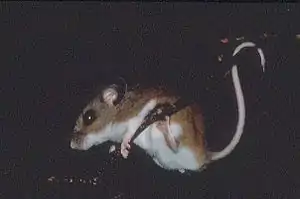 White- Footed Mouse |
- 1 2 3 4 5 6 Aguilar, Shaina, Peromyscus Leucopus, white footed mouse, http://animaldiversity.ummz.umich.edu/accounts/Peromyscus_leucopus/, retrieved (October 7, 2012)
- 1 2 Saunders, D.A. (1988), Adirondack Mammals, p. 216, http://www.esf.edu/aec/adks/mammals/whitefooted_mouse.htm, retrieved (October 7, 2012)
Deer Mouse
| Peromyscus maniculatus (Deer Mouse) | |
|---|---|
|
Family: Cricetidae
Size: Deer mice range in size from 5 to 8 inches (127 mm to 203.2 mm) long. An average weight for deer mice is only about 0.59 oz to 3.88 oz (15 to 110 grams). Newborn mice only weigh 0.04 oz to 0.07 oz (1 to 2 grams). Depending on the species, the tail may be significantly shorter or longer than their body.[1]
Description: Deer mice acquired their name because of their similar characteristics to deer. For example, they have the same type of fur that is dark on the back and white on the legs and underside with a bicolored tail that is dark on top and light on the bottom. In addition, they are agile and can jump and run similar to deer.[2] Peromyscus maniculatus have rounder bodies with large, black, beady eyes and large ears with little hair.
Similar Species: Because there are seven different types of mice within the species Peromyscus, it is hard to tell the difference between each subspecies.[3] Deer mice are the most common and widespread of the species and can be identified by their larger eyes and ears, overall body size, and bicolored tail. House mice have nearly furless tails with a predominately gray-brown coat.[3] When comparing species, the North American deer mouse has smaller forelimbs than hind limbs.[1]
Range: The deer mouse has one of the most extensive geographic distribution of any North American rodent. They range in areas from Canada to subtropical Mexico.[1]
Habitat: The deer mouse occupies almost every type of habitat within its range such as forests and grasslands.[4] One of the only types of habitats they avoid are wetlands.[2]
Diet: Deer mice feed primarily on seeds but may also consume fruits, invertebrates, fungi, insect larvae, and green vegetables.[3]
Activity: Deer mice are nocturnal and spend the day sleeping in their nests. They build their nests out of stems, twigs, leaves, roots, and other fibrous materials. The inside of their nests may be lined with fur, feathers, or cloth. Often time, nests are found in tree hollows, stumps, roots, and under rocks and logs but are always within the deer mouse’s range of 1/3 to 4 acres.[3][4] Unlike some species, deer mice do no hibernate. Instead, they become torpid during extreme weather but remain with their family in their nest.[3]
Reproduction: Deer mice reproduce depending on the type of climate they live in. In warmer regions deer mice will typically breed year round, typically every three to four weeks, from spring until fall. In cooler regions, deer mice often do not breed during the winter or undergo delayed implantation. The gestation period for females is about three weeks. Females will have about 2 to 4 litters per year with about 1 to 8 young per litter.[4] Upon birth, babies are blind, deaf, and have transparent skin and whiskers.[2] In only one week a baby mouse will have doubled in weight. After about 2 to 3 weeks, females wean their young and they become sexually mature at 7 to 8 weeks. Usually mice born in the spring and summer will breed within the same year.[2] Mates stay together during the breeding season but will take new mates in the spring.[4]
Lifespan: When in captivation, the North American deer mouse can live up to eight years but wild deer mice only live up to a year or less on average.[1]
Notes: Unfortunately, deer mice are the primary carriers of the hantavirus. Hantavirus is a dangerous syndrome affecting many humans throughout the United States. It is a pulmonary virus that affects the lungs of humans. First recognized in 1993, this virus has spread and has affected 131 people in the United States. Of the people affected, half have died.[2] People are suggested not to handle wild mice and to report sightings. If droppings are found, it is advised to use disinfectant solutions, such as Lysol or bleach, for a ten minute duration before removing the droppings from the area.[3] Deer mice can also be harmful to agricultural crops because seeds are their number one food source. Crops that have the ability to be affected are seeds in row crops, melon, alalfa, almonds, avocado, pomegranates, and sugar beets.[3] |
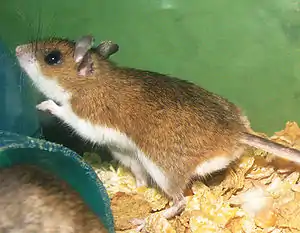 Deer Mouse |
Deer mice not only cause the destruction of current crops, but they may also prevent the regrowth of new plants and crops.[1]
- 1 2 3 4 5 Bunker, A. (2001), "Peromyscus maniculatus", Animal Diversity Web, http://www.animaldiversity.ummz.umich.edu/accounts/Peromyscus_maniculatus/, retrieved October 8, 2012
- 1 2 3 4 5 Graham, D. (n.d.), "Deer Mice", Northern State University: Aberdeen, SD., http://www3.northern.edu/natsource/MAMMALS/Deermi2/htm, retrieved September 24, 2012
- 1 2 3 4 5 6 7 Quinn, N.; Baldwin, R. A.; Timm, R. M. (n.d.), "Deer Mouse Management Guidelines—UC IPM", Home Page – UC Statewide IPM Program, http://www.ipm.ucdavis.edu/PMG/PESTNOTES/pn74161.html, retrieved September 24, 2012
- 1 2 3 4 Timm, R.; Howard, W. (n.d.), "White-footed and Deer mouse, Peromyscus maniculatus, control and management", The Handbook: Prevention and Control of Wildlife Damage (1): 1–22, http://www.icwdm.org/handbook/rodents/whitefooteddeermouse.asp, retrieved September 24, 2012
Western Harvest Mouse
| Reithrodontomys megalotis (Western Harvest Mouse) | |
|---|---|
|
Family: Cricetidae
Size: 2.3-3.0 in (59-77 mm) in length, 0.21-0.38 oz (6-11 g) in weight
Description: The Western Harvest Mouse is a small, long-tailed rodent that has prominent, orange-tipped ears.[1][2] It is among the smallest rodents in Minnesota with a brown back and whitish belly.[3] Its tail is bi-color, with a scaly appearance covered by hair.
Similar Species: It is difficult to distinguish the Western Harvest Mouse from similar species, but it is slightly larger than the Plains Harvest Mouse, the Sonoran Harvest Mouse, and the Eastern Harvest Mouse. Also, its hair is shorter and its tail is more distinctly bi-color than the Salt Marsh Harvest Mouse.[1]
Range: The Western Harvest Mouse is commonly found in southwestern Canada, southward to southern Mexico, western United States, the central Rockies, and central and upper Midwest.[1][4] Although rare in Minnesota, it is commonly found in the southern region.[3]
Habitat: Old fields, meadows, weedy roadsides, agricultural areas, grassy situations within pine-oak forests, and near the banks of rivers. It prefers dense vegetative cover, and may also be found in shrubby arid regions. The Western Harvest Mouse builds spherical nests that are usually located on the ground under heavy grass, bushes, weeds, or fallen logs.[4][5]
Diet: It is a granivore and herbivore. It mainly eats seeds, but it also eats some herbaceous material and insects.[2][4]
Activity: It is primarily a nocturnal and non-hibernating species, and is most active on moonless, rainy nights.[1]
Reproduction: The Western Harvest Mouse breeds year round, but mostly during the early spring to late autumn with a reduced midsummer activity. Its gestation period lasts 23-24 days, with an average litter size of 6, and it is able to produce multiple litters annually. The young sexually mature in 2-4 months.[1][5]
Lifespan: Few reach the age of 12 months.[1] |
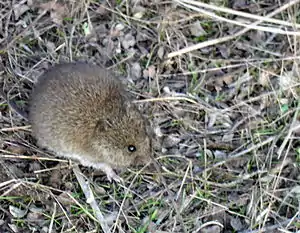 Western Harvest Mouse, Reithrodontomys megalotis |
- 1 2 3 4 5 6 Webster, W. D.; Jones, J. K. Jr. (1982), "Reithrodontomys megalotis", Mammalian Species (167): 1–5, http://www.science.smith.edu/msi/, retrieved September 23, 2012
- 1 2 Reid, F. A. (2006), Mammals of North America, Boston, NY: Houghton Mifflin Company, pp. 289–290
- 1 2 Hazard, E. B. (1982), The Mammals of Minnesota, Minneapolis, MN: The University of Minnesota Press, p. 83
- 1 2 3 Linzey, A. V.; Matson, J. (2008), "Reithrodontomys megalotis", IUCN Red List of Threatened Species (Version 2012.1), http://www.iucnredlist.org, retrieved September 28, 2012
- 1 2 NatureServe (2012), "Reithrodontomys megalotis", NatureServe Explorer: An online encyclopedia of life (Version 7.1), http://www.natureserve.org/explorer, retrieved September 28, 2012
House Mouse
| Mus musculus (House Mouse) | |
|---|---|
|
Family: Muridae
Size: Length: 2.5 to 3.75 inches (65 to 95mm)
Tail length: 2.3 to 4 inches (60 to 105mm) Weight: .42 to 1.06 ounces (12 to 30g)Description: The house mouse's fur color ranges from light brown to black. They typically have white fur on their bellies. They have long furless tails with circular scales.
Similar Species: The house mouse is very similar in appearance to the deer mouse and white footed mouse. It can be distinguished from the two by its naked tail and relatively small ears.
Range: The house mouse has a range all over the world, and they can be found on every continent except for Antarctica.[1]
Habitat: The house mouse usually lives close to humans, rarely straying away from buildings. They can also be found in fields and barns. They typically cannot be found in forests or deserts.[2]
Diet: In the wild, the house mouse eats plant matter and insects. In houses they will eat any food that is available.
Activity: They are generally nocturnal, sometimes active during the day.
Reproduction: Males have more than one female mate at a time. Females usually have 5-10 litters a year consisting of 3-12 offspring. House mice reach sexual maturity at 5-7 weeks old.[1]
Lifespan: House mice can live up to 18 months in the wild, and up to 5 years in captivity.
Notes: House mice are common throughout all parts of the world. In homes they are considered a pest, so they are often exterminated. They will look for food in homes and store what they find which can often create a stench. They have been domesticated as the 'fancy mouse' and are kept as pets. House mice are able to run very quickly and can also swim well, climb, and jump.[1] |
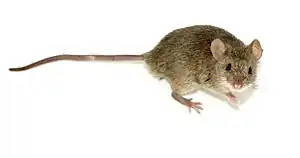 House Mouse |
- 1 2 3 Ballenger, L. (1999), "Mus musculus", Animal Diversity Web, http://animaldiversity.ummz.umich.edu/accounts/Mus_musculus/, retrieved October 4, 2012
- ↑ Musser, G.; Amori, G.; Hutterer, R.; Kryštufek, B.; Yigit, N.; mitsain, G. (2008), "Mus musculus", IUCN Red List of Threatened Species, http://www.iucnredlist.org/details/13972/0, retrieved October 4, 2012
Norway Rat
| Rattus norvegicus (Norway Rat) | |
|---|---|
|
Family: Rodents (Muridae) [1]
Size: Total Length: 17.3 inches (440 mm.) Tail: 8 inches (205 mm.) Weight: 14-17.6 oz. (400-500 g.) [2]
Description: Large and robust. Belly is mostly gray. Tail is shorter than body, dark above and pale below.[3] Blunt nose. Ears are relatively small and close to body. Large and protruding eyes.[4]
Similar Species: The Norway rat is similar to the Roof Rat; but differs in that the Norway rat is large and robust and the roof rat is sleek and agile. The tail of the Norway rat is shorter than the tail of the roof rat. The nose of the Norway rat is blunt while the nose of the roof rat is pointed. The eyes and ears on Norway rats are small while the roof rats’ are large.[3]
Range: Live throughout the 48 contiguous United States.[3] Native to China, Japan, and Russia. Occurs worldwide.[1]
Habitat: In the wild present in lowland and coastal regions.[1] Lives as a commensal in close association with humans, principally in basements, ground floor, or burrows under sidewalks or outbuildings.[2]
Diet: Cereal grains, meats, fish, nuts, and some fruits.[3]
Activity: Nocturnal. Most feeding occurs half hour after sunset and before sunrise.[4]
Reproduction: At low densities in a burrow: Polygynous, one male mates with multiple females. At high densities: Polygynandrous, multiple males mate with multiple females.[5] Prolific breeders,[2] usually have 4-7 litters per year.[4] Gestation is 21-23 days. Litter size from 2-14. Born naked and blind. Eyes open in 14-17 days. Weaned at 3-4 weeks old.[2]
|
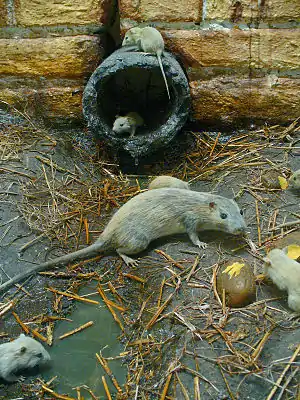 |
- 1 2 3 Ruedas, L. (2008), Rattus norvegicus, http://www.iucnredlist.org/details/19353/0, retrieved September 24, 2012
- 1 2 3 4 5 Norway Rat (Rattus norvegicus), http://www.nsrl.ttu.edu/tmot1/rattnorv.htm, retrieved September 24, 2012
- 1 2 3 4 Rat Management Guidelines--UC IPM, http://www.ipm.ucdavis.edu/PMG/PESTNOTES/pn74106.html, retrieved September 24, 2012
- 1 2 3 4 Norway Rat, Victor, http://www.victorpest.com/advice/rodent-library/norway-rats, retrieved September 24, 2012
- ↑ Wild Norway Rat Behavior, http://www.ratbehavior.org/WildRats.htm, retrieved September 24, 2012
Woodland Jumping Mouse
| Napaeozapus insignis (Woodland Jumping Mouse) | |
|---|---|
|
Family: Zapodinae
Size: Length overall: 8-10 inches (204-256mm), body length: 3-4 inches(80-100mm), tail length: 4.5–6 inches (115-160mm). Weight is usually 0.6-0.9 ounces (17-26g), though that will increase as much as 50% when preparing for hibernation.[1]
Description: The woodland jumping mouse resembles the shape of most mice. It has a fine white underbelly and a rougher top coat of fur that gives it a distinct reddish brown tri color, which camouflages it against dead leaves and trees along the forest floor. Other distinguishing features include its long hind legs and long tail.[1]
Similar Species: Perhaps the most striking differentiation is that the meadow and woodland jumping mice hibernate where most other mice don’t. While both woodland and meadow are similar in appearance with long tails and hind legs, the woodland variety has a white tipped tail.[2]
Range: This species can be found throughout northeastern portions of North America. From the arrowhead region of Minnesota through mostly the upper peninsula of Michigan into Canada through northern Quebec, extending south along the Appalachian Mountains into Georgia.[1][3]
Habitat: Not surprisingly, woodland mice prefer woodlands; forested areas with thick undergrowth consisting of ferns, shrubs and grasses. Damp swampy lowlands or mossy mountainous regions provide a suitable habitat.[4]
Diet: Primarily herbivorous but will consume insects and worms in addition to leaves, roots, seeds, fruit, and nuts. These mice also eat fungi inadvertently providing nutrients to surrounding trees, playing an important role in the forest ecosystem
Activity: Woodland jumping mice may be active during the day but they are mostly nocturnal. They hibernate from September to May in burrows up to 4.5 feet (1.5m) deep. They are not typically aggressive amongst themselves and are known to share food. They can increase their body weight as much as 50% during the summer months to prepare for hibernation.[4]
Reproduction: Breeding is seasonal and mating occurs after females come out of hibernation - males emerge first – as early as mid may but more commonly in June. Mice in the southern range can have two litters in one season despite being slow to develop. It takes approximately 35 days for offspring to wean and grow hair.[4]
Lifespan: Longer than most small North American mammals, the woodland jumping mouse can live 3-4 years in the wild.[3]
|
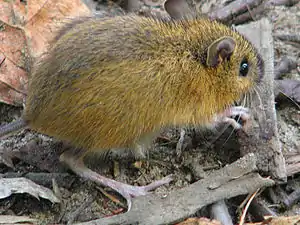 Woodland Jumping Mouse |
References
- 1 2 3 4 Wrigley, R ((1972)), "Napaeosapus Insignis", Mammalian Species 14: (1–6), http://www.science.smith.edu/msi/pdf/i0076-3519-014-01-0001.pdf, retrieved (October 16, 2012)
- ↑ Minnesota Department of Natural Resources, Lemmings, Mice Rats and Voles, http://www.dnr.state.mn.us/mammals/mice_voles_rats/index.html, retrieved (October 16, 2012)
- 1 2 "Napaeosapus Insignis", NatureServe, (2003), http://www.natureserve.org, retrieved (October 16, 2012)
- 1 2 3 4 Harrington, E. ((2004)), Napaeozapus Insignis, Animal Diversity Web, http://animaldiversity.ummz.umich.edu/accounts/Napaeozapus_insignis/, retrieved (October 16, 2012)
Meadow Jumping Mouse
| zapus hudsonius (Meadow Jumping Mouse) | |
|---|---|
|
Family: Dipodidae
Size: Meadow Jumping Mice range in length from 180 to 240 mm. The hind feet are 28 to 35 mm long.
Body weight typically depends on the time of year; they weigh more prior to hibernation,up to 35 g. During the summer, weights average between 16 and 19 g.[1]
Description: Meadow Jumping Mice are recognized by their extremely long tails, long hind feet, and slender build. Adults have a dorsal dark or olive brown band, which is paler in juveniles. The sides are a pale yellowish-brown, with black hairs lining the sides, and the underparts are white. The tail is sparsely haired, dark brown on top, and white on the bottom, and is longer than the body length. Meadow jumping mice are the only mammal with eighteen teeth. The upper jaw is characterized as having short, narrow, and longitudinally grooved incisors; small cheek teeth; and a small premoloar that generally precedes the molars.
Similar Species: The Meadow Mouse is similar in appearance to the Woodland Jumping Mouse except they do not have a white-tipped tail and are typically duller in color.
Range: This species is found throughout northern North America.They are found as far North as Alaska and as far south as New Mexico giving them the widest distribution of mice in the subfamily Zapodinae.[2]
Habitat: Meadow Jumping Mice live in various habitats that have some herbacious cover. They prefer moist grasslands and avoid heavily wooded areas. Grassy fields and thick vegetated areas bordering streams, ponds, or marshes generally support greater numbers of this species.[3]
Diet: Meadow Jumping Mice primarily eat seeds, but also feeds on fruit, insects, and berries.
Activity: Meadow Jumping Mice are solitary, but not aggressive toward others. They are generally nocturnal (although occasionally diurnal), and usually move in short hops of about 2.5 to 15 cm or by crawling along vole runways or in the grass. They are also great swimmers, diggers, and can climb. These mice are relatively nomadic, and may roam up to 1 km in search of moist habitat. They also hibernate during the winter.[4]
Reproduction: The breeding season of Meadow Jumping Mice occurs after hibernation in late April or May. Males emerge from hibernation slightly before the females and are reproductively active when the females emerge. Gestation is usually about 18 days, but may be longer for females who are already nursing a litter. Females typically have 2 to 3 litters in a year with an average of 5.3 young per litter. Small and weighing about 0.8 g, the neonates are naked, pink, blind, clawless and deaf, but squeak audibly at birth. In the first week, their ears unfold, fur begins to cover their backs, and their claws appear. They begin crawling between one and two weeks, and by the third week they can hop, creep, and hear. Their incisors have erupted, and they have tawny coats. By the end of the fourth week, the young have adult pelage, and open eyes. Weaned, they become independent during the 4th week.[5]
Lifespan: <1 year in the wild, or up to 5 years in captivity
Notes: The Meadow jumping mouse can jump up to 3 feet in length in its first jump which it then follows with a series of smaller jumps. |
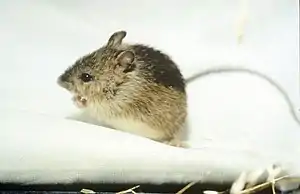 Meadow Jumping Mouse |
- ↑ Template:Citation Smithl
- ↑ Whittakerl, J.O. (1972), "Zapus Hudsonius", Mammalian Species (189): 1–7, http://www.science.smith.edu/msi/pdf/i0076-3519-011-01-0001.pdf, retrieved October 10, 2012
- ↑ Whittakerl, J.O. (1972), "Zapus Hudsonius", Mammalian Species (189): 1–7, http://www.science.smith.edu/msi/pdf/i0076-3519-011-01-0001.pdf, retrieved October 10, 2012
- ↑ "Meadow Jumping Mouse", Mammals of Minnesota: 106–109., 1982
- ↑ "Meadow Jumping Mouse", Mammals of Minnesota: 106–109., 1982
Plains Pocket Mouse
| Perognathus flavescens (Plains Pocket Mouse) | |
|---|---|
|
Family: Heteromyidae [1]
Size: These mice weigh 0.15–0.35 pounds (7–16 grams). The length of the animals range from 4.3 to 6.1 inches (110- 155mm) with the tail length being between 1.92 and 3.5 inches (49 and 89 mm).[2]
Description: The small mouse is distinguishable by visible, external, fur-lined cheek pouches that no other mouse in Minnesota has. Their fur color is generally a tan buff color with a mix of brown and black hair on its upper side and back and may have white spots on it's belly.[1]
Similar Species: The P. apache or silky pocket mouse is very similar to the plains pocket mouse and has been debated if it should be considered a subspecies of the pocket mouse or remain two different species.[2]
Range: Plains pocket mice are found in the North America Great Plains region, with a range from Mexico to Minnesota and the Dakotas.[2]
Habitat: The mouse lives in temperate, terrestrial habitats made of loose, sandy soil with moderate vegetation. They commonly build vertical burrows underneath bushes or other plants. The burrows are used for nesting as well as food storage.[2]
Diet: Granivore, mostly seeds and sometimes ants. They will also eat grains, oats, and different types of grasses. Water they drink comes from seeds.[2]
Reproduction: Produce 2-3 litters per year, with approximately 2-7 offspring per litter. They mate around April until late summer. Mice usually start mating at the age of 10-17 weeks.[2]
Lifespan: 1-2 years, sometimes longer.[2] |
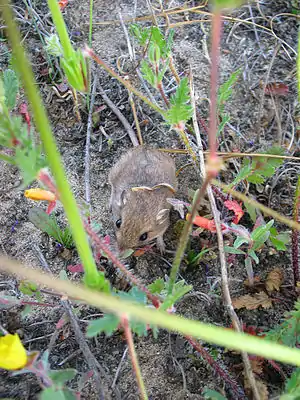 This is a pocket mouse but not a plains pocket mouse. This is a Pacific pocket mouse (Perognathus longimembris pacificus) |
- 1 2 Linzey, A.V.; Timm, R.; Alvarez-Castaneda, S.T.; Castro-Arellano, I.; Lacher, T. (2008), Perognathus Flavescens, http://www.iucnredlist.org/details/16634/0, retrieved (September 25, 2012)
- 1 2 3 4 5 6 7 8 Spencer, Victoria (1997), Perognathus Flavescens, plains pocket mouse, http://animaldiversity.ummz.umich.edu/accounts/Perognathus_flavescens/, retrieved (October 4, 2012)
Porcupines
North American Porcupine
| Erethizon dorsatum (North American Porcupine) | |
|---|---|
|
Family: Erethizonidae
Size: Total length: 25-40 inches, 645-1030 mm
Tail length: 6-12 inches, 145-300 mm Height: 1-2 inches, 25-42 mm Weight: 7-40 pounds, 3.5-18 kg [1]Description: A prickly, barb covered creature that is dark brown and black in color. Quills found on dorsal surface are white tipped to ward off predators.[2] Lack canine teeth and possess exceptionally long claws.[3]
Similar Species: The North American Porcupine is similar to the Central or South American porcupine, but is more likely to be found in a cold environment.[2]
Range: North American Porcupines are found in the northern tier of the United States, specifically Alaska and California. The northern Great Lakes region, including Minnesota, also houses a large number of this species.[3]
Habitat: Open tundra and deciduous forests are common habitats for the North American Porcupine. Groundcover, trees, and stone den shelters are utilized based on climate and elevations. During winter months, it is more common to find a porcupine in stone lodging, but will make due with trees if that is their only option.[3]
Diet: All porcupines are herbivores. Foods rich in nitrogen, protein, and fiber such as bark, phloem, twigs, sugar maple buds, etc. are often consumed as staples in their diets.[3]
Activity: Porcupines are nocturnal, as they feed at night in order to harness additional nutrients in their foods. Their dominant and protective nature keeps both males and females within a specific “home range” for approximately three rounds of mating.[3]
Reproduction: Females initiate mating season annually by marking their territories and emitting vaginal secretions attracting males. Males will fight to mate with specific females. Alpha males are typically larger in nature, providing a good line of genetics to the offspring. When females have been fertilized, their gestation period will span around 200 days. Offspring are cared for by the female, gaining full independence within a year of birth.[2]
Lifespan: Up to 18 years.[2]
Notes: A porcupine's quills act as a high quality defensive mechanism, both warding off predators through an ominous color contrast (white on black) and by acting as a barrier when under attack.[3] |
 |
- ↑ Woods, C.A. (1973), "Erethizon dorsatum", Mammalian Species 29: 1–6
- 1 2 3 4 Weber, Christopher (2012), North American Porcupine, http://animaldiversity.ummz.umich.edu/site/accounts/information/Erethizon_dorsatum.html, retrieved September 23, 2012
- 1 2 3 4 5 6 Shefferly, Nancy; Weber, Christopher (2012), North American Porcupine, http://www.biokids.umich.edu/critters/Erethizon_dorsatum/, retrieved September 23, 2012
Rabbits, Hares & Pikas
Rabbits & Hares
Snowshoe Hare
| Lepus americanus (Snowshoe Hare) | |
|---|---|
|
Family: Leporidae
Size: Total length: 20 in. (508 mm.). Tail Length: 2 in. (50.8 mm.). Weight: 3 lbs. (1.36 kg).[1]
Description: The Snowshoe Hare is a medium-sized rabbit. It has a brown coat in the summer, and a white coat during the winter.[1]
The soles of its hind legs are densely furred and large, forming the characteristic snowshoe.[2]
Similar Species: The Snowshoe Hare is similar to but slightly taller than the Eastern Cottontail Rabbit (Sylvilagus floridanus).[1]
Range: Northern species found as far north as Alaska and over most of Canada.[1]
Diet: Grass, clover, and ferns in the summer. Bark and twigs in the winter.[1]
Also eat their own feces.[2]
Activity: Nocturnal.[3]
Most active during dawn and dusk during periods of low light. Sleep and groom throughout the day.[2]
Reproduction: Mates in February through July. Gestation period of 36 days. Typical litter size of 4 (3-4 litters per year).[1]
Weaned at 14-28 days. Polygynandrous (males and females both have multiple mates).[2]
Lifespan: 5 years in the wild. Up to 85% do not live longer than 1 year.[2]
Notes: Much of the Snowshoe Hare’s digestion occurs in the hindgut. Therefore, to extract all of the available nutrients they will often eat their own feces to cycle their food through a second time. The Snowshoe Hare can run up to 27 MPH and leap 10 ft. in a single bound.[2]
Common predators include Coyotes (Canis latrans) Lynxes (Lynx lynx), Snowy Owls (Bubo scandiacus), and Red-Tailed Hawks (Butao jamaicensis).[1] Snowshow Hare’s are accomplished swimmers and often swim to escape predators (2). Snowshoe Hares have very dramatic population fluctuations over 10-year cycles thought to be accredited to over-grazing. Females are typically larger than males.[4] |
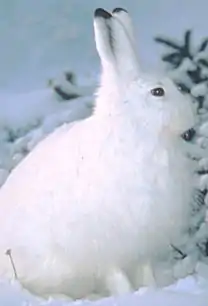 Snowshoe Hare Lepus americanus |
References
- 1 2 3 4 5 6 7 8 Minnesota Department of Natural Resources (2012), Lepus americanus
- 1 2 3 4 5 6 7 Shefferly, N. (2007), Lepus americanus
- ↑ Smithsonian National Museum of Natural History (2012), Lepus americanus
- ↑ Ruland, C. (2012), Lepus americanus
White-tailed Jackrabbit
| Lepus townsendii (White-tailed Jackrabbit) | |
|---|---|
|
Family: Rabbits and Hares (Leporidae)
Size: White-tailed jackrabbits weigh 6.61 to 8.81 lbs (3 to 4 kg), and range from 22 to 25.6 inches (558-650 mm) in total length.[1]
Description: The white-tailed jackrabbit’s coat color varies with season and habitat. The back ranges from yellowish to grayish brown in color while the underside is white or grey. The throat and face are darker with coarser hair. Its tail is white with a buffy dorsal stripe. Their ears are rimmed in white and tipped in black. Two distinguishing features are their large ears and hind legs.[2]
Similar Species: The white-tailed jackrabbit is the least social of all hares.[2] They can also be distinguished from other hares due to their prominent flanges projecting from the sides.[1]
Range: The white-tailed jackrabbit’s range within the United States including: Washington, Oregon, California, Nevada, Idaho, Montana, Wyoming, Utah, Colorado, New Mexico, Nebraska, Kansas, North and South Dakota, Minnesota, Wisconsin, Iowa, Missouri, and Illinois.[3]
Habitat: The white-tailed jackrabbit is typically found in open grasslands, forests, pastures, and fields.[2]
Diet: White-tailed jackrabbits are strict herbivores. They want grasses, forbs, and shrubs in varying amounts.[2]
Activity: White-tailed jackrabbits are nocturnal. They generally feed from sunset to sunrise and rest in shallow forms during the day. They do not hibernate in the winter.[2]
Reproduction: The White-tailed jackrabbit’s breeding season extends from February to July with a peak from March to June. gestation typically lasts 42 days. Their litter size ranges from 1 to 11, but averages at 4-5. Females may have one to four litters per year, however a maximum of one litter is produced in northern climates. The young are fully weaned at one month, and sexually mature after 7-8 months.[2]
Lifespan: Up to 5 years in the wild.[3]
Notes: The white-tailed jackrabbit is the least social of all hares. In terms of communication, the species generally make no vocal noises, but screams if caught or injured. They have acute hearing and a sharp sense of smell. They also have good vision and whiskers that allow them to navigate to find food. These senses help them perceive their environment.[2]
The white-tailed jackrabbit is a favorite prey of animals such as foxes, coyotes, cougars, badgers, bobcats, snakes, eagles, and owls. They avoid predators by lying perfectly still. They are also proficient swimmers, which helps them to escape predators.[2] White-tailed jackrabbits are a large population and are considered a “least concern” species by the IUCN Red List of Threatened Species.[3] |
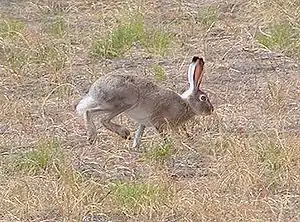 White-tailed jackrabbit |
- 1 2 Wallmo, O.C. (1984), "Odocoileus hemionus", Mammalian Species (219): (1–9)
- 1 2 3 4 5 6 7 8 Gosline, A. (2001), ADW:Lepus townsendii: INFORMATION, http://animaldiversity.ummz.umich.edu/accounts/Lepus_townsendii/, retrieved October 7, 2012
- 1 2 3 Smith, A.T.; Johnston, C.H. (2008), Lepus townsendii (White-tailed Jackrabbit), http://www.iucnredlist.org/details/41288/0, retrieved October 7, 2012
Eastern Cottontail
| Sylvilagus Floridanus (Eastern Cottontail) | |
|---|---|
|
Family: Rabbits and Hares
Size: Total Length: 12-16 inches (304.8-406.4mm) [1]
Tail Length: No more than 2 inches (25-54mm) [2] Weight: 2-3 pounds (0.9-1.4 kg) [1]Description: This large cottontail has long, dense fur that ranges in color from brown to grey. The underbody and tail are white. Some may have fur that looks patchy in color.[2]
Similar Species: The Eastern Cottontail has a patch of fur on its neck that may be yellow-brown to black which distinguishes it from other species.[2]
Range: The Eastern Cottontail is found in the middle to eastern parts of the United States and the northern parts of South America. They may be found in small parts of the southwest and northwest United States. In Minnesota specifically, they are grossly populated throughout the entire state.[3]
Habitat: This species lives in a variety of diverse habitats. These habitats include prairies, deserts, swamps, glades, and various types of forests. The Eastern Cottontail also may reside in areas that are more developed such as farms, pastures, and shrubs.[3]
Diet: This species is a herbivore. The Eastern Cottontail’s diet varies based on the time of year. In the winter, this species eats twigs and bark. In the summer, they eat green plants such as clover or grass. At times, the Eastern Cottontail may eat its droppings to consume nutrients.[1]
Activity: The Eastern Cottontail is most active at dawn and dusk. If the moon is out, they may be more active during the night. The Eastern Cottontail is more active in the winter than the summer especially during times when there is more snow and less food around. The species' highest activity level is in the winter, when the temperature is between 0 and 33 degrees Fahrenheit.[2]
Reproduction: Reproductive seasons vary based on the location of the animal. Cottontails living at higher elevations start their breeding seasons later than those living at lower elevations. The average gestation is 28 days. Most females have 3-5 babies per litter and have 3-4 litters each year. The Eastern Cottontail is prolific meaning the female can be bred shortly after giving birth. The female may abandon her babies if she gets pregnant again. The babies would then live alone in a ground nest for about three weeks.[1]
Lifespan: The average lifespan of the Eastern Cottontail is 15 months in the wild. Their potential lifespan is 10 years, but most do not survive their second year.[2] In captivity, the Eastern Cottontail may die of shock instantly.[1]
Notes: According to the IUCN Red List, the Eastern Cottontail is of least concern for threatened species. Eastern Cottontails are a very common species in Minnesota. In fact, they are one of the most common mammals seen here. Most predators hunt Cottontails including humans who may enjoy eating their meat. Babies are the size of the human thumb at birth. |
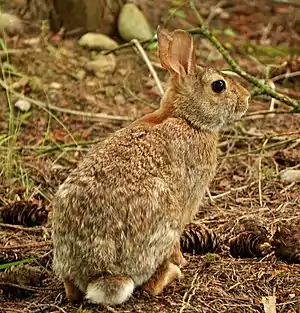 Eastern Cottontail |
- 1 2 3 4 5 Minnesota Department of Natural Resources (2012), Eastern Cottontail, https://www.dnr.state.mn.us/mammals/easterncottontail.html, retrieved (October 4, 2012)
- 1 2 3 4 5 Chapman, J; Hockman, J (1980), "Sylvilagus Floridanus", Mammalian Species 136: 1–8, http://www.science.smith.edu/msi/pdf/i0076-3519-136-01-0001.pdf, retrieved October 4, 2012
- 1 2 Mexican Association for Conservation and Study of Lagomorphs; Romero Malpica, F; Rangel Cordero, H (2008), Sylvilagus floridanus, http://www.iucnredlist.org/details/41299/0, retrieved (October 8, 2012)
Shrewforms
Shrews
Northern Short-tailed Shrew
| Blarina brevicauda (Northern Short-tailed Shrew) | |
|---|---|
|
Family: Soricidae
Size: Total Length: 4.3-5.5 inches (11-14cm)
Tail Length: about 20% of total length [1] Weight: 0.35-1oz. (10-30g)Description: Soft dark gray fur that covers even the ears. Pointed head attaches to robust body. They also have chestnut colored teeth [1]
.[2]
Similar Species: The difference between Southern Short-tailed Shrew and the Northern Short-tailed Shrew is where they live. Northern Short-tailed shrews generally live north of Oklahoma. The tooth structure is slightly also slightly different.
Range: Northern Short-tailed shrews live in central and eastern United States and Canada, mostly keeping north of Oklahoma.
Habitat: The Northern Short-tailed shrew lives in woodlands with lots of brush cover, sticks and leaf-litter. Nearby food is also a necessity, so shrews will leave if they cannot find enough to eat.
Diet: Shrews eat worms, snails, centipedes, beetles, invertebrates, mice, and smaller shrews. They eat up to 3 times their body weight per day.
Activity: Northern short-tailed shrews are nocturnal, but can be active 24 hours a day. Most of a shrew’s energy is spent constructing narrow burrow systems or moving in where other animals lived
.[3]
Reproduction: Northern short-tailed shrews breed from February – November, peaking in mid-spring and late summer or early fall. Young may reproduce at 60 days. Gestation is 20-21 days. Birth litters are 4-5 shrews in a nest, and these nests are constructed ideally under a fallen log with ample brush cover.
Lifespan: Northern short-tailed shrews live about 1.5 years.
Notes: Northern Short-tailed shrews have poison in their saliva that allows them to attack their predators and prey in the face, paralyzing and preserving the creature until the shrew is ready to eat. The poison is not deadly to humans. In the wild they try to kill each other and live alone, but in captivity they will sleep together peacefully and try to get to the bottom of the pile.[1] |
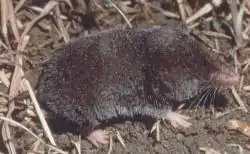 Northern Short-tailed Shrew |
References
- 1 2 3 George, S.B.; Choate, J.R. (1986), B.J.Verts; K.J.J.Jones; T.E.Lawlor, eds., "Blarina brevicauda", Mammalian Species (Los Angeles, CA) 261: 1–9, http://www.science.smith.edu/msi/
- ↑ Whitaker, J.O. (1980), A.A.Knopf, ed., "Short-tailed Shrew (Blarina brevicauda)", Audubon Society Field Guide to North American Mammals (New York: Chanticleer Press, Inc.): 48, 279, 291–293
- ↑ NatureServe (2012), "Northern Short-tailed Shrew", NatureServe Explorer: An Online Encyclopedia of Life., http://www.natureserve.org
Least Shrew
| Cryptotis parva (Least Shrew) | |
|---|---|
|
Family: Soricidae
Size: Total Length – 2.7 to 3.4 inches (68 to 86 mm); Tail Length – 0.5 to 0.7 inches (13 to 18 mm); Weight – 0.1 to 0.2 oz (4 to 6.5 grams) [1]
Description: Least shrews have dense, short hair; which is dark brown to reddish brown on the dorsal side during the winter. Fur becomes grayish brown in color during the summer. They have a bi-colored tail, with a darker brown on top and a lighter underside.[1]
Similar Species: Smallest of the shrews, they can be distinguished by their tail length.
Range: The least shrew is widely distributed across the eastern United States, and southward into Central America. However, it is only known in Minnesota from a single male specimen collected in Winona County.[2]
Habitat: Least shrews are commonly found in open fields with tall grasses or areas with fallen trees and brush that provide protection.[1]
Diet: Least shrews eat insects, earthworms, snails, and carrion. When those types of food are scarce they may eat seeds and fruit. Emergency supplies of food are stored.[3]
Activity: Least Shrews are social animals and often share burrows. They make nests out of leaves or dig burrows, which they line with leaves and grass. They also will use old burrows and runways of other mammals, such as voles.[4]
Reproduction: Least shrews may reproduce several times during the mating season, which lasts from February to November. Gestation lasts 21 to 23 days. Females give birth to an average of 5 young per litter, though litters can range from 2 to 7 individuals.[1]
Lifespan: Least shrews tend to live a little over a year in the wild. Captive least shrews can live for roughly 21 months.[1]
Notes: Carnivorious mammals capture and kill these shrews, but rarely eat them because of the specialized skin glands that are distasteful to these carnivores. The principal gland is the flank gland, which is better developed in males than females after sexual maturity.[3] |
 Least Shrew |
- 1 2 3 4 5 ADW: Cryptotis parva: INFORMATION, http://animaldiversity.ummz.umich.edu/site/accounts/information/Cryptotis_parva.html, retrieved September 21, 2012
- ↑ Species profile: Minnesota DNR, http://www.dnr.state.mn.us/rsg/profile.html?action=elementDetail&selectedElement=AMABA04010, retrieved Spetember 21, 2012
- 1 2 Shrews (Family Soricidae), http://kufs.ku.edu/libres/mammals_of_kansas/cryptotus-par.html, retrieved Spetember 21, 2012
- ↑ Least Shrew, http://www.fcps.edu/islandcreekes/ecology/least_shrew.htm, retrieved Spetember 21, 2012
Arctic Shrew
| Sorex Arcticus (Arctic Shrew) | |
|---|---|
|
Family: Shrew
Size: • Total length:
o 3.9 to 4.9 in (100 to 125 mm) • Tail length: o 1.4 to 1.8 in (36 to 45 mm) • Weight: o .18 to .47 oz (5.3 to 13.5 g) [1]Description: This particular species is similar to the size of a mouse and is a medium size compared to other shrews. The back of this animal is a darker brown. The sides are light brown. The stomach has a more gray like brown color. The tail starts out dark and then ends in a dark brown.[1]
Similar Species: • The tri colored body is what distinguishes this from others like it. This shrew is also larger than the others in its family.
• Another distinguishing trait is that its tail has dual colors unlike others in its family.[2]
Range: • This species ranges from the Arctic Circle as far down as the northern part of the United States.
• They go as far as east as Quebec and up to the Atlantic coastline. They go as far west as southern Yukon. • They are typically found in Minnesota, North and South Dakota, Michigan, and Wisconsin.[3]Habitat: • This species prefers to live in moist, open areas. Particularly in Minnesota they favor living in marshes that surround rice lakes.
• However, this particular species of shrew is also able to adjust to other habitats depending on what part of the country this animal is found.[2]
Diet: • These animals are insectivorous.
o The types of insects that this animal eats in particular are grasshoppers, larch sawflies, and some aquatic insects as well. o Generally they forage in the ground for their food but have also been known to climb plants to get their food.[3]Activity: • These animals are mostly active at night and are considered to be nocturnal. They also spend part of their time awake during the day making them diurnal as well.[3] They are typically not active between the hours of 6:00 AM and 10:00 AM.[2]
• When they are awake they tend to move quite quickly. During periods of inactivity they generally lay on their side or stomach with their heads tucked under. • This species is also a very solitary animal that does not survive well with others.[3]Reproduction: • This species is generally promiscuous in its mating. Males often move farther away from their homes than the females to mate.[3]
• Females typically have 1 or 2 litters in their lifetime. It is characteristic in Minnesota that the first litter is born sometime between April to late August with most occurring in June. • Gestation lasts around 13 to 21 days. Lactation typically is 20 to 24 days. • Weaning lasts about 5 to 6 weeks. • The average litter size of this shrew is 6.8 per litter. • The offspring reach sexual maturity at the age of 12 months.[4]Lifespan: • The lifespan of this animal is typically 18 months.[3]
Notes: In the wilds of Minnesota it will be quite hard to find this tiny animal as they are only about 4 inches long. Oddly they are considered to be a large size compared to other shrews in the family. To distinguish this shrew from others you will have to look at the coat and tail of it. The coat is tri colored and the tail gets darker as it comes to the end. This animal generally eats insects and will go to great lengths to get them including climbing large plants. It will be easy to find these animals during the day but they can especially be found at night searching for food. In Minnesota it would be most easy to find them in wet land areas such as marshes and swamps. This animal is quite adaptable in that it can adjust to a variety of climates making it a great animal for Minnesota. These animals are very solitary in nature. In captivity when 2 of them are together one always suspiciously dies with no signs of any sort of fight between them. |
 The northern short tailed shrew is very similar to the arctic shrew with the same body type and similar size |
- 1 2 "Arctic Shrew-Sorex Arcticus", Montana Field Guide, http://fieldguide.mt.gov/detail, retrieved September 23, 2012
- 1 2 3 Lariviere, Serge (1999), "Sorex Arcticus", Mammalian Species (608): 1–9, http://www.science.smith.edu/msi/, retrieved September 23, 2012
- 1 2 3 4 5 6 Seto, Stephanie (2006), "Sorex Arcticus, Arctic Shrew", Animal Diversity Web, http://animaldiversity.ummz.umich.edu/accounts/Sorex_arcticus/, retrieved September 23, 2012
- ↑ Clough, Garrett (1963), "Biology of the Shrew", American Midland Naturalist (69): 69–81, http://www.jstor.org/stable/2422844, retrieved September 23, 2012
Masked Shrew
| sorex cinereus (Masked Shrew) | |
|---|---|
|
Family: Soricidae
Size: The masked shrew usually weighs between .08-1.4 ounces (2.5-4.0g) and is approximately 3.9 inches (10cm) in length. Average length of the tail is 1.5 inches (3.9cm), comprising over 40% its the total length.[1]
Description: The fur along the back is brown, while underside fur is white. The coat tends to be darker overall in winter. The tail is brown above and pale underneath, with a blackish tip.[2]
Range: The masked shrew is the most widely distributed shrew found in North America. They occur throughout the northern United States, most of Canada, and Alaska. They do not occur on Vancouver Island, the Queen Charlotte Islands, in tundra habitats, arctic islands, or in extreme northern Quebec.[3]
Habitat: The masked shrew typically live in open and closed forests, meadows, river banks, lake shores, and willow thickets. Habitat suitability depends on the availability of water and the highest population densities can be found in moist environments where water is easily accessible.[4]
Diet: The Masked shrew is omnivorous although they are on the carnivorous side as they primarily eat a variety of insects primarily consisting of ants.They also commonly consume insect larvae and caterpillars.[citation needed]
Activity: Masked shrews are primarily nocturnal and are solitary. They can run fast to protect themselves from predation.[5]
Reproduction: Young become sexually active at 2 months although few females have their first litter until the spring after their birth. Their average litter size is around 6.5 neonates at birth the young can exhibit movements but cannot crawl,see, or hear. they are weaned and grown enough to leave the nest at 27 days of age.[6]
Lifespan: The masked shrew typically lives 1-2 years.[7]
Notes: All shrews (including the masked shrew) have a very high metabolic rate which includes and very fast heart beat. Some shrews have had their heartbeats measured at 1200 beats per minute. To maintain themselves they must eat their weight in food every day. This is accomplished by eating every few minutes. With a heart beating so fast the animals are easily startled and with deadly consequences, as they have been known to die of fright after a loud burst of thunder. |
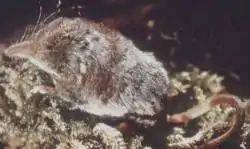 Masked Shrew |
- ↑ Leel, W. (2010), Masked Shrew, http://animaldiversity.ummz.umich.edu/accounts/sorex_cinereus/, retrieved October 10, 2012
- ↑ "Sorex Cinereus", Mammalian Species (743): 1–9., 2004, http://www.science.smith.edu/msi/pdf/743_Sorex_cinereus.pdf, retrieved October 10, 2012
- ↑ "Sorex Cinereus", Mammalian Species (743): 1–9., 2004, http://www.science.smith.edu/msi/pdf/743_Sorex_cinereus.pdf, retrieved October 10, 2012
- ↑ Leel, W. (2010), Masked Shrew, http://animaldiversity.ummz.umich.edu/accounts/sorex_cinereus/, retrieved October 10, 2012
- ↑ Leel, W. (2010), Masked Shrew, http://animaldiversity.ummz.umich.edu/accounts/sorex_cinereus/, retrieved October 10, 2012
- ↑ Hazardl, E. (1982), "The Masked Shrew", Mammals in Minnesota: 21–27
- ↑ Hazardl, E. (1982), "The Masked Shrew", Mammals in Minnesota: 21–27
Northern Water Shrew
| Sorex palustris (American Water Shrew) | |
|---|---|
|
Family: Soricidae
Size: Length: 5 to 7 inches. (130 to 170mm)
Tail length: 2.2 to 3.5 inches. (57 to 89mm) Weight: 0.28 to 0.6 ounces. (8 to 18g)Description: The coat appears black or dark grey, but it seems browner in the summer and blacker in the winter. Its hind feet are larger than its front feet, and its tail is darker on the top and lighter on the bottom.[1]
Similar Species: The Glacier Bay water shrew is sometimes classified as being an American water shrew, though the two are different species.
Range: The American water shrew can be found in Alaska, Canada, and the northern American states.
Habitat: American Water Shrews live in forests near streams or other water sources.
Diet: They mostly feed on aquatic insects but will also feed on land insects and vegetation. The water shrew will usually hunt any small creature that it can overpower.[2]
Activity: They are active during the day and night. For every half hour of activity the American water shrew spends one hour resting. The American water shrew is a solitary creature.[2]
Reproduction: The breeding season is from December to September. 1 to 2 litters are produced during each season with a litter of 3 to 10 offspring. They reach sexual maturity in the winter following their birth.[2]
Lifespan: Their typical lifespan is 18 months.
Notes: Water shrews are relatively large compared to other shrews and are classified as long tailed shrews. They forage for food in the water and are able to swim in water all year long. Some water shrews have been seen walking on the surface of water as well. One suggestion as to how they can walk in water is that they are able to trap air bubbles between the hairs on their feet. They are aggressive creatures and fighting is common between both males and females.[2] |
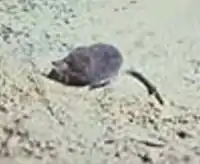 American Water Shrew |
- ↑ Beneski, John; Stinson, Derek (1987), "Sorex palustris", Mammalian Species: 1–6, http://www.science.smith.edu/msi/, retrieved October 12, 2012
- 1 2 3 4 Carmen, M. (2001), "Sorex Palustris", Animal Diversity Web, http://animaldiversity.ummz.umich.edu/accounts/Sorex_palustris/, retrieved October 9, 2012
Pygmy Shrew
| Sorex hoyi (Pygmy Shrew) | |
|---|---|
|
Family: Soricidae
Size: Total length: 2-4 inches, 67-98 mm
Tail length: 1-2 inches, 25-34 mm Weight: less than 1 pound, 2.2-6.6 grams [1]Description: Slim skull with pointed face. Covered in soft fur, gray-brown in color with lighter underside.[2]
Similar Species: The major distinguishing factor between Pygmy Shrews and other species of the same genus are the number of unicuspid teeth on the top jawline, 3, as opposed to four or five.[1]
Range: Pygmy Shrews are permanent residents across much of North American, specifically in northern Canada, east-Central United States, and the large majority of Minnesota.[1]
Habitat: Preferred habitats for the Pygmy Shrew seem to be northern forests, edges of tundrous regions, and in mountainous terrain. They may be found in both soft and hardwood forests, as well as burrowing within moist soils, pre-constructed tunnels, and other biotic litters.[3]
Diet: Pygmy Shrews are omnivores, tending to lean more toward a carnivorous existence. Insects and small invertebrates make up much of their diet. Pygmy shrews eat constantly, as they are so small and have extremely high metabolic rates.[4]
Activity: Very little is known about Pygmy Shrew activity, although controlled environment testing show a high level of feeding, climbing, and sleeping throughout the entire day, identifying more with a crepuscular mammal.[4]
Reproduction: Pygmy shrews mate during the summer months, gestating for approximately 18 days. A typical litter holds between three and eight offspring. Little is known about post-birth maternal care, aside from the fact that offspring must nurse for some period of time. These offspring are ready to mate two years after birth.[3]
Lifespan: Up to 2 years.[3]
Notes: Smallest American mammal.[2] |
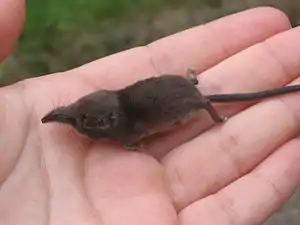 |
- 1 2 3 Montana Field Guide, Pygmy shrew: sorex hoyi, http://fieldguide.mt.gov/detail_AMABA01250.aspx, retrieved September 23, 2012
- 1 2 Long, Charles A. (1974), "Microsorex hoyi and microsorex thompsoni", Mammalian Species 33: 1–4
- 1 2 3 University of Michigan, Pygmy shrew, http://www.biokids.umich.edu/critters/Sorex_hoyi/, retrieved September 23, 2012
- 1 2 Saunders, D.A. (1988), Pygmy Shrew, http://www.esf.edu/aec/adks/mammals/pygmy_shrew.htm, retrieved September 23, 2012
Moles
Star-nose Mole
| Condylura cristata (Star-nose Mole) | |
|---|---|
|
Family: Talpidae
Size: Total Length – 6.89 to 8.07 inches (175 to 205 mm); Weight – 1.23 to 2.64 oz (35 to 75 g) [1]
Description: The star-nose mole has a blackish brown appearance; their body is covered in black-brown water-repellant fur. Long tail, four large legs covered in scales. They have 11 pairs (22 total) of fleshy pink tentacles at the end of their snout that makes the nose look like a star.[2]
Similar Species: Unlike any other species; easy to differentiate with their tentacles on their nose.
Range: The main distribution range of these animals extends to the north-eastern US and eastern Canada. They are found in places like Labrador, Quebec, Minnesota, Indiana and South Dakota. These mammals can also be found along the Atlantic Coast and in the Appalachian Mountain area.[2]
Habitat: They are semi-aquatic animals preferring low wet areas. The tunnels of these moles often lead below water surfaces. They can be found in wet meadows, marshes, banks of streams, lakes and ponds.[2]
Diet: These small mammals feed on various small insects and fishes including ants, worms, beetles, mollusks and snails.[2]
Activity: Spends most of the time burrowing tunnels; this species is active by day as well as by night, spending about half of each 24 hour period resting or sleeping curled upright with the head bent under the forelimbs.
Reproduction: The breeding season starts in mid-March and continues through April. They reproduce once every year, but the females may reproduce a second time if their first litter is unsuccessful. One litter may contain 2- 7 offspring.[2]
Lifespan: 3 to 4 years in the wild.
Notes: The nose is the principal sensory organ of the Star Nosed Moles as they cannot see. The tentacles covering the edges of the nose contain 25,000 highly sensitive touch receptors. These completely hairless tentacles help them in hunting. They identify insects, invertebrates or any other consumable substance around them by the help of these tentacles. They hunt by touching their prey. It takes them very little time to decide if a substance is edible. The whole hunting process takes an average 230 ms (millisecond- a thousandth of a second) to complete once they find their prey.[2] |
 Star-nose Mole |
- ↑ North American Mammals: Condyluracristata, http://www.mnh.si.edu/mna/image_info.cfm?species_id=47, retrieved Spetember 23, 2012
- 1 2 3 4 5 6 Star Nosed Mole, http://www.animalspot.net/star-nosed-mole.html, retrieved Spetember 23, 2012
Eastern Mole
| Scalopus aquaticus (Eastern Mole) | |
|---|---|
|
Family: Talpidae
Size: Head and body length: 110mm to 170mm (4.33in to 6.96in)
Tail length range: 18mm to 36mm Range mass: 32g to 140g (1.13os tp 4.93oz) Average mass: 74.6g (2.63oz)Description: The Eastern Mole’s body is covered with a thick velvety fur that varied from a color from silver to black to copper. Their short tail is round and almost hairless. As for their feet there are some hairs above or upper portion but naked or hairless below and the feet are quite large. There are web between the toes of each foot which are to help with all the diggings (Gorog, 1999). They don’t have any eyes or ears. But it’s thought that the poorly developed eye may be effective in detecting light (Gorog, 1999).
Habitat: These are found from eastern South Dakota, Michigan, southeastern Wyoming, Central Texas, south to the tip of Florida and north to Ontario and New England. There is a small amount of population found in southwestern Texas and in northwestern Mexico. They prefer fields, meadows, pastures and open woodland.
Diet: Eastern mole most likely eat earthworms and also eat insects and their larvae, some vegetation, and in captivity will eat ground beef, dog food, mice, and small birds. They eat up to 25%-100% of their own weight in food each day (Gorog, 1999).
Activity: The eastern moles are not solitary. They have high energy requirements and needs a considerable amount of food daily (Gorog, 1999). They can dig up to 4.5 meters in one hour with their powerful forefeet and are good swimmers. Even though they have no vision, they may be able to detect the presence or absence of light. Also their ears are cover by a layer of skin but again, they may be able to detect sounds and vibrations. They probably find their way around and detect prey by the use of their acute and senses of smell and touch (Gorog, 1999).
Reproduction: The female has a litter of around three to five young after about 44 days and the litters are born anytime from late February through early June. The eastern mole will have only one litter per year. Newborn don’t have any fur and are in a plant-like nest that are in one of the deeper chambers. This is where they will stay until about four weeks old. They will become adult size by three months and can breed at the end of year one.
Lifespan: One captive animal will usually live longer than 36 months but in the wild, these eastern moles likely live less than this (Gorog, 1999). But their average lifespan is 3 years. |
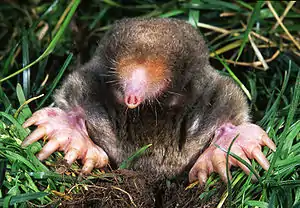 |
Bats
Vesper Bats
Silver-haired Bat
| Lasionnycteris Notivagans (Silver-Haired Bat) | |
|---|---|
|
Family: bat family
Size: • Total length:
o 3.6 to 4.5 in (92 to 115mm) • Tail length: o 1.4 to 1.8 in (35 to 45mm) • Weight: o .28 to .39 oz (8.1 to 11g) [1]Description: This particular bat has a distinguishing black coat with silver or white tips. They also have black wings and black ears. Their ears are short, rounded, and have no hair on them.[1]
Similar Species: • The most distinguishing feature of these bats is the color of their hair. They are easy to spot because they are the only bats that have that particular silver tipped hair.[1]
Range: • This animal can be found throughout North America.
• They range from as far north as Alaska and as far south as Mexico. • They range from as far west as California and as far east as Georgia.[1]Habitat: • This species prefers to live in temperate areas in the northern woodlands that has some source of water nearby.
• They generally roost in trees such as willows, ash, and maple trees. It is not as common but they have also been known to roost in some buildings. • In the winter they roost inside of trees, buildings, and the cracks of rocks.[2]Diet: • These animals are insectivorous
o They eat small, soft bodied insects such as flies, moths, mosquitoes, beetles, and crickets. o They generally look for food in the tree tops but they also search in small clearings and near water.[3]Activity: • These animals are nocturnal. At night they fly generally late compared to other bats starting after other animals have already started eating.[1]
• They have 2 periods in the night that they are active. Their first period is typically 2 to 4 hours after sunset and their second occurs 6 to 8 hours after sunset.[1] • They have a generally slow flight speed of 15.7 f/s (4.8 m/s).[2] • Unlike other bats they do not hibernate in the winter they actually migrate south towards Mexico in the autumn and then return north in the spring.[1]Reproduction: • This species in particular species reproduces in a unique way called delayed fertilization. Mating occurs from August to October and then ovulation occurs in April to May when they return north.
• The typical female has around 1 to 2 offspring in each attempt. • The gestational period is approximately 50 to 60 days. • Weaning lasts until the offspring is around 3 to 4 weeks old. • Offspring reach sexual maturity typically in the late summer or fall.[4]Lifespan: The life span of this particular bat is generally 12 years of age.[4]
Notes: Silver haired bats, along with any other kind of bat should be considered Minnesotan’s best friend as they eat the mosquitoes and other insects that bother us every year. This bat can be distinguished from others because of its black hair with white or silver tips. It is a medium sized bat that has a small wingspan compared to others. It is nocturnal so a night trip will be necessary to see this extraordinary animal. Look for them in the later part of the night as they generally fly much later than other bats. This bat is typically found in woodland areas near water but otherwise all over Minnesota and the rest of the country. They prefer to live in willow, ash, or maple trees. In the winter they do not hibernate as most animals do they migrate south making it impossible to spot them during that time. However, you will not want to get too close to these animals as this particular bat has been known to be common carriers of rabies. |
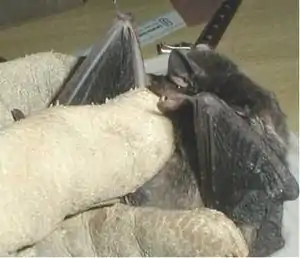 Silver haired bat in captivity |
- 1 2 3 4 5 6 7 Kunz, Thomas H. (1982), "Lasionnycteris Notivagans", Mammalian Species (172): 1–5, http://www.science.smith.edu/msi/, retrieved September 23, 2012
- 1 2 Arroyo Cabrales, J.; Miller, B.; Reid, F.; Cuaron, A.D.; de Grammont (2008), "Lasionnycteris Notivagans", IUCN Red List of Threatened Species, http://www.iucnredlist.org, retrieved September 23, 2012
- ↑ "Lasionycteris Noctivagans", Bat Conservation International, 2012, http://www.batcon.org/index.php, retrieved September 23, 2012
- 1 2 Smith, Josh (2004), Silver-Haired Bats, http://www.life.umd.edu
Eastern Red Bat
| Lasiurus Borealis (Eastern Red Bat) | |
|---|---|
|
Family: Bat (Vespertilionidae)
Size: The average length of the Eastern Red Bat is 4.28in (108.9mm). The average length of it's tail: 2.07in (52.7mm). It's average weight: .4 ounces.[1]
Description: The Eastern Red Bat is moderately sized with long, pointed wings. It has small feet with ears that are low, broad, and rounded. Its fur is a rusty red with tints of light brown and white.[2]
Similar Species: The feature that will distinguish the Eastern Red Bat from any other species is their hair color. The rusty red tint is unlike any other fur color from the bat family.[3]
Range: The Eastern Red Bat's population is all over North and South America. In Minnesota, this bat can be seen in all parts of the state.[1]
Habitat: Their habitats tend to be heavily human populated areas with trends of urban areas. Their habitats can be trees, shrubbery, and sometimes near the ground.[4]
Diet: This species dines on moths and beetles.[2]
Activity: Eastern Red Bats are nocturnal and thrive at night. It spends most of the day sleeping. This species migrates south for the winter in late summer.[3]
Reproduction: Mating takes place in flight and copulation occurs in August or September. Female Red Bats give birth to twins each year. Their young learn to fly at about 5 weeks old and it takes them about another 5 weeks to learn to fly on their own.[4]
Lifespan: The Eastern Red Bat's lifespan is about 12 years of age.[2]
Notes: The Eastern Red Bat is known as one of the most beautiful bats in all of North America. Its red color and piercing eyes make it stand out from the rest. This species is on the “least concerned” list when it comes to extinction because of its wide distribution, large population, and habitat tolerance. They prefer to live in trees and hang there to sleep during the day and live/hunt at night. They have been recorded in existence since the mid 1800’s. This bat does not form large colonies and is a very independent species. |
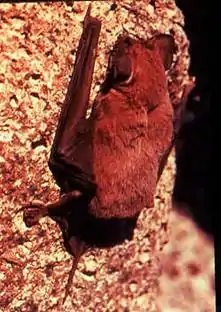 Eastern Red Bat |
- 1 2 Shump, Karl (1982), Lasiurus Borealis, The American Society of Mammalogists, pp. 1–6
- 1 2 3 Arroyo-Cabrales, Jay; Reid, F (2008), Lasiurus Borealis, IUCN Red List of Threatned Species, p. 1
- 1 2 Davis, Andrew (2010), Pelage color of red bats lasirrus borealis varies with body size, Journal of Zoology, pp. 401–405
- 1 2 Kurta, Allen (2010), Reproductive timing, distribution and sex ratios of tree bats in lower Michigan, Journal of Mammalogy, pp. 586–592
Hoary Bat
| Lasiurusc cinereus (Hoary Bat) | |
|---|---|
|
Family: Vespertilionidae
Size: Total Length: 5.3 inches (134.5millimeter)
Tail Length: 2.3 inches (57.5millimeter) Weight: .7-1.2 ounces (20-35 grams)Description: Black to dark brown starting at the base, followed by a cream colored band, and then a strip of mahogany brown. Has a yellowish-brown collar under its chin along with black-rimmed yellow ears. Has long, soft fur that starts at the tip or the tail and ends by the wrists on the underside of the wings.
Similar Species: This species is one of the few tree-dwelling bats that is spread widely throughout North and South America.
Range: The hoary bat has a range from Argentina and Chile, extending northward into Canada. They are mostly concentrated in the Plains States and the Pacific Northwest.
Habitat: This species can mainly be found in forests with small open areas and live in hollowed out areas, like woodpecker holes and squirrel nests. Females normally nest in deciduous trees, while the males prefer coniferous trees. Most bats favor areas that have dense vegetation above and no obstructions below their nest, allowing them to drop and gain flight.
Diet: The hoary bat focuses its diet on moths and beetles along with mosquitos.
Activity: In the winter months, this species migrates to coastal areas around south San Francisco, from South Carolina to central Florida, and throughout the Gulf States. They are nocturnal and feed once in the early evening and once before sunrise.
Reproduction: Females usually give birth between the middle of May and the end of June. Litter size ranges from one to four pups. Young are born blind and deaf, with their ears and eyes opening 3 days after birth. They learn to fly 33 days after birth.
Lifespan: The hoary bat lives for 6 to 7 years.[1] |
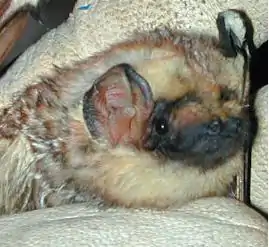 Hoary Bat |
- ↑ Texas Parks and Wildlife, Hoary Bat (Lasiurus cinereus), http://www.tpwd.state.tx.us/huntwild/wild/species/hoary/, retrieved 9-23-12
Little Brown Myotis
| Myotis lucifugus (Little Brown Bat) | |
|---|---|
|
Family: Vespertilionidae
Size: Little brown bats range in length between 2 to 4 inches (50.8 mm to 101.6 mm) and only weigh about 5 to 15 grams (0.18 oz to 0.53 oz). Their wingspan ranges from 9 to 10.5 inches (228.6 mm to 266.7 mm).[1] While both sexes appear similar, males are generally smaller than females.[2]
Description: Little brown bats have fur that is glossy and varies from dark brown, golden brown, reddish, to olive brown. The abdominal region is lighter in color.[1] Unlike the rest of their body, the wings of little brown bats are nearly hairless and dark brown or black.
Similar Species: The little brown bat lacks the brownish vascular membrane of the eyeball and folded retinas so they do not exhibit eye shine like other species.[1] They have a blunt tragus, or an extra piece of cartilage sticking out from the base of each ear, and fur is typically longer, darker, and more glossy than others. Other distinguishing factors include the length of the ears, pelage length and sheen, and ear color.[3]
Range: Little brown bats are found in abundance in southern Alaska, Canada, across the United States, and in high, forested elevations in regions of Mexico.[1] Little brown bats are absent from hot, arid lowlands such as areas in northern Canada, Florida, the Great Plains regions, southern California, and the coasts of Virginia and North and South Carolina. They are located in Iceland and Kamchatka, which may have been a result of overseas travel.[1]
Habitat: Little brown bats occupy three different types of roosts: day, night, and hibernation. Active bats occupy day and night roosts in buildings, trees, under rocks, and in piles of wood. Most roosts have very little to no light and provide good shelter and high humidity. Night roosts include confined spaces in which large clusters of about 300,000 bats can group together to increase the temperature.[1] Day and night roosts are different in order to prevent accumulation of feces and to avoid attracting predators.[4] In the winter, a hibernation roost is used. These hibernation roosts may be shared with the Myotis yumanensis and include areas such as abandoned mines and caves where temperatures are above freezing and humidity is high. Unlike day and night roosts, hibernacula are not found in or around buildings.[1]
Diet: Insects make up the primary diet of little brown bats. Like birds, little brown bats catch their prey by aerial hawking and gleaning. Typically, little brown bats feed on swarms of insects in order to save time and energy. If a feeding area is successful these bats tend to go back to the same site. Types of insects that are consumed by these bats are beetles, aquatic insects, caddisflies, moths, midges, mayflies, lacewings, and mosquitoes.[1]
Activity: Little brown bats do hibernate in the winter. Northern populations enter hibernation is early September whereas southern populations enter hibernation in November. Northern populations end their hibernation period in mid May whereas southern populations end in mid March.[4] Some populations may migrate for the winter but never too far from their original location.
Little brown bats are primarily nocturnal and begin to hunt during the dusk hours and return before dawn.[1] In order to communicate, bats use ultrasonic calls that are beyond the range of human hearing. Calls usually last about 4 milliseconds. When hunting, these bats call about 20 times per second and increase their calls to 200 per second when approaching their prey. Calls allow bats to locate, track, and evaluate prey.[2]
Reproduction: There are two phases in the mating process. These include the active phase in which both partners are awake and alert and the passive phase in which males mate with inactive individuals. During the active stage, females often times mate with several males and during the passive stage males mate with multiple females.[1] Mating occurs during the late summer and fall and is called swarming.[1] Females delay ovulation and store sperm for up to seven months until fertilization takes place in the spring. Females have a 50 to 60 day gestation period and pups are born in June and July. Most bats hang upside down, but females giving birth hang with their heads facing upwards. Unlike other species, the little brown bat only gives birth to one pup each year. Pups are born with a full set of teeth and open their eyes and ears within hours of birth. It takes about three weeks before a pup can finally fly and feed on insects. After about four weeks, pups reach their adult weight and become self-supporting.[1]
Lifespan: Usually little brown bats live up to 6 to 7 years in the wild with the males leading longer lives than the females.[1]
Notes: Evidence suggests that the little brown bat may be entering an extinction stage because of the widespread disease called white-nose syndrome.[3] WNS is a disease that affects hibernating bats. When the disease is visible, the nose of the bat or other hairless parts, such as the wings, have a layer of white fungus. First detected in the winter of 2006-2007 in New York, this disease has continued to spread throughout the bat community into many regions of the United States. So far 5.7 to 6.7 million bats in eastern North America have been killed with a death rate of 90 to 100 percent in some hibernacula. Scientists are still researching the disease and trying to find a way to control it.[5]
In addition to the day and night roosts, females occupy nursery roosts. These roosts are similar to day roosts but are warmer and are usually only occupied by females and their offspring.[4] The same nursery roost is used each year.[1] These types of roosts are usually located in and around buildings but may also be found in hollow trees and other natural crevices. Typically during feeding little brown bats will eat half their body weight, but nursing females can eat up to 110 percent of their body weight.[2] |
.jpg.webp) Little Brown Bat |
- 1 2 3 4 5 6 7 8 9 10 11 12 13 14 Havens, A. (2006), "Myotis lucifugus", Animal Diversity Web, http://animaldiversity.ummz.umich.edu/accounts/Myotis_lucifugus/, retrieved September 24, 2012
- 1 2 3 "North American Mammals:Myotislucifugus", Smithsonian Institution National Museum of Natural History NMNH, n.d., http://www.mnh.si.edu/mna/image_info.cfm?species_id=199, retrieved September 24, 2012
- 1 2 Kunz, T.; Reichard, J. (2009), "Status Review of the Little Brown Myotis (Myotis lucifugus) and Determination that Immediate Listing Under the Endangered Species Act is Scientifically and Legally Warranted", Myotis Status Review (1): 1–22, http://www.bu.edu/cecb/files/2010/12/Final-Status-Review.pdf, retrieved September 24, 2012
- 1 2 3 Barclay, R. (1980), "Myotis lucifugus", Mammalian Species (142): 1–8, http://www.science.smith.edu/msi/, retrieved September 24, 2012
- ↑ U.S. Fish and Wildlife Service (2012), "White-nose syndrome: the devastating disease of hibernating bats in North America", White-Nose Syndrome.org: 1–2, http://www.whitenosesyndrome.org/sites/default/files/resource/white-nose_fact_sheet_9-2012.pdf, retrieved October 8, 2012
Northern Myotis
| Myotis septentrionalis (Northern long-eared myotis) | |
|---|---|
|
Family: Vespertilionidae
Size: The average length of the Northern myotis is 2.90- 3.3 inches (74-84mm) long, the length of the tail averaging at 1 inch (26mm), and it weighs between .17- .35 oz (5- 10g). They have a wingspan of 9-10 inches (22.86- 25.4cm).[1] Compared to other Myotis species, these bats have long ears with a relatively long tragus in each ear.
Description: The Northern myotis is a small bat with dull, gray-brown pelage. It has relatively long ears that extend beyond the tip of the nose when laid forward. It also has a narrow and sharp-pointed tragus, which is the externally visible cartilaginous structure of the external ear.[2][3]
Similar Species: Similar species of the Northern myotis include the Myotis sodalis and the Myotis lucifugus, from which it can be distinguished by having ears that extend beyond the tip of the nose when laid forward and a long, pointed tragus.
Range: The northern myotis is widely distributed over eastern and northern North America, but has been known to stretch all of the way down to Texas.[2]
Habitat: The Northern myotis hibernates in caves and mine tunnels. It is also found heavily in forested areas, and have been known to roost in buildings, under shingles of buildings, under exfoliating tree bark, and in caves and mines.[3][4]
Diet: The Northern myotis tend to forage in forest interiors, and their long ears allow them to find stationary insects. The diet focuses on moths, which often are often captured by gleaning, or plucking, the insects from a surface. They do eat other insects, which include caddisflies, beetles, flies, and leafhoppers, and generally hunt 1 to 3 meters from the ground.
Activity: During autumn, the Northern Myotis gathers into groups of a few hundred individuals for the purpose of mating, followed by hibernation. They forage at dusk or shortly after sunset and again at dawn, resting periodically throughout the night and roost during the day, being largely nocturnal.[3]
Reproduction: Mating occurs in autumn when groups of a few hundred, known as “swarming”, are formed and pairs mate before going into hibernation. The gestation period for he Northern myotis is 50-60 days, after which a single young bat is born. Young are generally born in late June or early July. Female bats nurse their young for about a month, and give birth to one young bat a year.[5]
Lifespan: Northern Myotis have been known to live up to 18.5 years.[3]
Notes: Male and female Northern Myotis bats roost separately; however, females with offspring may form small maternity colonies of less than 60 individuals.
Northern bats have good hearing and they often listen for sounds made by their insect prey. They also use echolocation to locate insects resting on leaves, tree trunks, or on buildings. As in the case with most bats, many humans consider northern bats to be pests. Bats often work their way into attics of houses and may carry a threat of rabies, although this is often exaggerated. The females of this species are generally larger and heavier than the males. There was only one reported specimen from Winterhaven in Dimmit County in Texas, making it doubtful that resident populations of this species occur in Texas.[3] Bats are the only mammals capable of flight. Long-eared bats are more of a forest dweller than other Myotis species. They are much more solitary in habits than other Myotis, generally found singly or in small groups containing up to 100 individuals.[1] Although sperm is transferred to the female during copulation that occurs in the fall, ovulation and fertilization of the egg are delayed until the females arouse from hibernation the following spring.[5] |
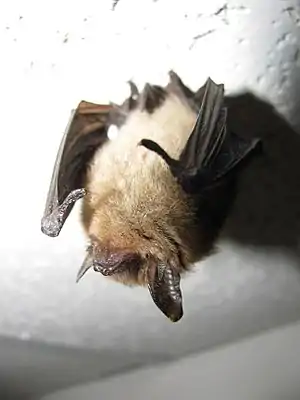 Northern myotis |
- 1 2 Bat Conservation of Wisconsin, http://www.batcow.org/northern_myotis.htm, retrieved (October 15, 2012)
- 1 2 Northern Myotis, http://www.nsrl.ttu.edu/tmot1/myotsept.htm, retrieved (October 15, 2012)
- 1 2 3 4 5 Northern Myotis - Myotis septentrionalis, http://www.tpwd.state.tx.us/huntwild/wild/species/northmyotis/, retrieved (October 15, 2012)
- ↑ Arroyo-Cabrales, J; Alvarez Castaneda, S. T. (2008), The IUCN Red List of Threatened Species, http://www.iucnredlist.org/details/14201/0, retrieved (October 15, 2012)
- 1 2 Kansas Mammal Atlas: Northern Myotis, (1999), http://webcat.fhsu.edu/ksfauna/mammals/index.asp?page=species&species_id=370-1119&dots=yes&tributaries=yes&isAnura=&map=, retrieved (October 15, 2012)
Tri-colored Bat (Eastern Pipistrelle)
| Perimyotis subflavus (Tri-colored Bat) | |
|---|---|
|
Family: Vespertilionidae
Size: Tri colored bat has a total length of 2.9-3.5 inches (73.66-88.9mm).[1] With wings spread, it has a length of 8-10 inches wide (203.2-254mm). It weighs from 5-8 grams (.005-.008kg).
[2]
Description: Tri-colored bats are seen with yellowish, grayish brown, reddish brown fur color. They have pink ears, face, and skin. Some of this specie has fur on their tails and some has light fur on theirs. Along with that, it is a weak flier.
Similar Species: Another specie that can be mistaken as a tri-colored bat is a mouse-eared bat. Mouse-eared bats have dark brown or black skins. Tri-colored bat have more of a short and round ear.[1]
Range: Tri-colored bats live in the central and western parts of the United States, western Canada, and the western part of Mexico. This specie is spotted all over Minnesota but mostly in the south western part of this state.[1]
Habitat: Caves, mines, tunnels, buildings, and edge of forests (trees) are where this specie lives.[3]
Diet: Tends to eat all insects such as moths, flies, beetles, mosquitoes, midges, bugs, and ants.[2]
Activity: Usually they are the first bats to hibernate in the fall and first to wake up from hibernation after winter. They cannot stand up to the cold and so they hibernate in warm areas such as deep in caves and mines. Tricolored bats are active in the daytime and sleeps/hides in the early evenings.[2]
Reproduction: Tri colored bats mate during the fall season and the female usually gives birth in spring to two twins. The young are born with hairless and closed eyes.[1] They tend to grow super fast and after 4 weeks to a month, the young tri-colored bat learns to fly.[2] When the young is 5-6 weeks old, it becomes independent to live its own life.[1]
Lifespan: Tri colored bats lives from an average of 10-15 years of age.[1]
Notes: Tri colored bats are rarely noticed because of their small sizes, fast turns, and blending in with the dark evening sky. The only way to spot them is if they fly in groups scattering around.[3] |
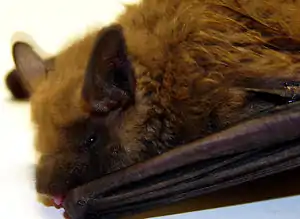 Tri-colored Bat |
- 1 2 3 4 5 6 Cuvier, F. (1832), Perimyotis subflavus, http://www.dnr.state.mn.us/rsg/profile.html?action=elementDetail&selectedElement=AMACC03020, retrieved October 7, 2012
- 1 2 3 4 Holliday, Cory (2004), Tri-colored Bat url= http://www.tnbwg.org/TNBWG_PESU.html
- 1 2 Tuttle, Merlin D. (2012), Perimyotis subflavus, http://www.batcon.org/index.php/all-about-bats/species-profiles.html?task=detail&species=2345&country=43&state=all&family=all&start=25, retrieved October 7, 2012
Carnivores
Cats
House Cat
Single Page View Field Guide/Mammals/House Cat
Canada Lynx
| Lynx canadensis (Canada Lynx) | |
|---|---|
|
Family: Felidae
Size: Total length: ~3 feet, 91 cm[1]
Tail length: 4 inches, 10 cm[1] Height: ~2 feet, 60 cm[2] Weight: 20-44 pounds, 9-20 kg[1]Description: Countoured body. Brown/gray and white fur on respective dorsal and parietal sides.[1] Oversized, hairy feet with sharp claws ideal for traversing snow-covered ground and hunting.[2]
Similar Species: Brown coloring, pronounced tufts of ear fur, distinctive short beard under chin,[1] and a black tip on stubbed tail [3] differentiate the Canada lynx from a bobcat.
Range: The Canada lynx is located across northern Canada, as well as the northwest United States stemming from British Columbia.[2] They can be found in northern Minnesota, specifically in the Arrowhead region.[1]
Habitat: The Canada lynx resides in coniferous forests where they can forge shelters from trees and other natural features.[2]
Diet: Canada lynx are carnivores that only reside where their ideal prey, the snowshoe hare, lives.[1] When resources are scarce, Canada lynx eat smaller mammals, such as mice and squirrels,[4] a variety of birds, and occasionally larger animals.[2]
Activity: The Canada lynx is considered nocturnal, as the majority of their hunting occurs at night. Their anatomy, including large, highly receptive ears, allows them to hear their prey and attack quietly.[4] These mammals are not incredibly quick, relying on their ability to be stealthy in order to catch their food.[2]
Reproduction: Mating season for the Canada lynx is the end of winter. A litter ranges between one and six kittens with an approximately two-month gestation period.[5] Females stay with the kittens after birth.[2]
Lifespan: 15-20 years.[2]
Notes: Since 2000, this mammal has been considered "federally threatened", not to be confused with an "endangered species."[1] |
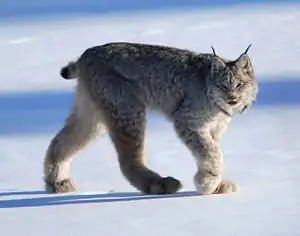 |
References
- 1 2 3 4 5 6 7 8 Minnesota Department of Natural Resources (2012), Mammals of Minnesota: Canada lynx, http://www.dnr.state.mn.us/mammals/canadalynx.html, retrieved September 23, 2012
- 1 2 3 4 5 6 7 8 Canadian Geographic, Canada lynx fact sheet, http://www.canadiangeographic.ca/kids/animal-facts/canada_lynx.asp, retrieved September 23, 2012
- ↑ University of Minnesota, Duluth (2009), Canada Lynx of the Great Lakes Region, http://www.nrri.umn.edu/lynx/, retrieved September 23, 2012
- 1 2 National Geographic, Lynx, http://animals.nationalgeographic.com/animals/mammals/lynx/, retrieved September 23, 2012
- ↑ Tumlison, R. (1987), "Felis lynx", Mammalian Species 269: 1–8
Bobcat
| Lynx Rufus (Bobcat) | |
|---|---|
|
Family: Felidae
Size: The bobcat stands 16-22 in (or 40-55 cm) and measures 24-40 in (or 60-100 cm) in length, not including its “bobbed” tail, which measures between 3-7 in (or 8-18 cm). Bobcats weigh between 10-70 lbs. (or 5-30 kg), with males usually weighing more than females.[1]
Description: The bobcat is a medium-sized member of the felidae (cat) family. Its name corresponds to its short, stubby tail. Their cheeks display large tufts of fur. Their fur is reddish-brown with whitish fur on the belly. Black spots and stripes can also be seen throughout the coat.[2]
Similar Species: The bobcat is very similar to other species of the Lynx genus, but is generally the smallest. In addition, the bobcat is very similar in appearance to their cousin, the lynx but is distinguishably smaller and has a characteristic short (bobbed) tail. Bobcats are also the only species in the cat family that display spotted and striped patterns throughout their fur.[3]
[4]
Range: Bobcats have a relatively large range. They can be found throughout North America, from southern Canada to northern Mexico, including most of the United States.[2]
Habitat: Bobcats habitat remote, well-forested areas such as cliffs, bluffs or forests. They can also be seen inhabiting hollow trees and logs. Habitats with an abundance of food and prey are ideal for bobcats.
[2]
Diet: They are carnivores and thus prefer a diet of meat. They mainly hunt rabbits and hares, but are known to eat rodents, birds, bats, and even adult deer.[5]
Activity: Bobcats are very active between dusk and dawn, making them uncommon to spot during the day. They are referred to be secretive, primarily hunting and moving during the night. Bobcats are solitary and territorial animals that display limited social behaviors.[6]
Reproduction: Bobcats begin breeding as early as February, but is most common during the months between March and April. Female bobcats have a gestation period between 50 and 70 days and give birth to litters of 3 or 4 kittens. Female bobcats are usually 3 years or older by the time they begin giving birth, and kittens will remain with their parents for almost a year.[6]
Lifespan: It is estimated that bobcats live as long as 10-12 years in the wild. But bobcats as old as 15 years have been documented. The greatest proportion of bobcats are between 0-1 years of age, with a steady decline as they age.[6]
Notes: Bobcats are the most common wildcat in North America. Bobcats often ambush prey by waiting very still and then pouncing.[5]
Each bobcat may have several dens in its territory. A main den is usually a cover or rock shelter or some other protected place such as a hollow log. Auxiliary dens are the less-used portions of the home, such as brush piles, rock ledges or stumps.[2] In the mid 1900s, bobcat populations in the Midwest United States were declining at a rapid pace due to the increased value of their fur. Beginning in the 1970s, international laws were set to protect bobcats. As a result of these laws, the bobcat population has replenished in many northern states. [2] |
 Lynx Rufus |
References
- ↑ Bobcats, n.d., http://nerrs.noaa.gov/doc/siteprofile/acebasin/html/sppgal/sgmammal.htm, retrieved (October 12, 2012)
- 1 2 3 4 5 Basic facts about bobcats, 2012, http://www.defenders.org/bobcat/basic-facts, retrieved (October 12, 2012)
- ↑ Ulmer, Fred, Melanism in the Felidae, with Special Reference to the Genus Lynx
- ↑ Bobcat Lynx rufus, http://naturalhistory.uga.edu/~gmnh/gawildlife/index.php?page=speciespages/species_page&key=frufus, retrieved (October 13, 2012)
- 1 2 Animal Fact Sheet: Bobcat, 2008, http://www.desertmuseum.org/kids/oz/long-fact-sheets/Bob-cat.php, retrieved (October 12, 2012)
- 1 2 3 Clark, W.R. (2011), Habitat Use and Social Structure, http://www.eeob.iastate.edu/faculty/ClarkW/html/gis_info.html, retrieved (October 12, 2012)
Cougar
| Puma concolor (Cougar (Puma)) | |
|---|---|
|
Family: Felidae
Size: Total length: males – 7.55 ft. females – 6.9 ft. (males - 2.3 m. females – 2.1 m.). Tail length: males – 2.5 ft. females – 2.3 ft. (males - .77 m. females - .7 m.). Weight: 121 – 143 lbs. (55-65 kg.).[1]
Description: The cougar is a large, slender cat with muscular limbs.[1]
They have grayish-brown to reddish-brown hair except for the tips on their tail and ears, which are black.[2]
Similar Species: The Bobcat (Lynx rufus) differs from the cougar mainly in size and tail length. Bobcats are typically much smaller than Cougars. Bobcats also have short tails, while Cougar’s tails can account for up to a third of their total length.[3]
Range: Cougars are found in western North America eastward to the Midwest. As well as north into Canada and south into Mexico.[4]
Diet: Carnivorous. Moose (Alces alces), Elk (Cervus elaphus), White-Tail Deer (Odocoileus virginianus), Bobcats (Lynx rufus).[3]
Reproduction: Polygamous. Mates year-round, but typically between April and September. Gestation period of 82-96 days. Typical litter size of 1-6 (1 litter every other year). Newborns weigh 14.1 oz. (400 g.) at birth.[1]
Weaned at 40 days.[3]
Lifespan: 8-12 years in the wild. 20 years in captivity.[2]
Notes: Cougars used to have the largest distribution of all American terrestrial mammals. They used to range from coast to coast throughout North America and from southern Argentina to southeastern Alaska. Hunting and habitat destruction by humans has restricted their present-day range.[3]
The most common cause of death is from humans. Cougars cannot roar, but they can purr.[1] Siblings will stay together for 2-3 months after leaving their mother.[2] |
 Cougar (Puma) Puma concolor |
References
- 1 2 3 4 5 6 Currier, M.J.P. (1983), Mammalian Species, pp. 1–7
- 1 2 3 4 5 Minnesota Department of Natural Resources (2012), Felis concolor, http://www.dnr.state.mn.us/rsg/profile.html?action=elementDetail&selectedElement=AMAJH04010, retrieved 9/25/12
- 1 2 3 4 Hamilton, Hundt, Piokowski, M., P., R., Mountain Lion, Puma, Cougar
- ↑ Dewey, Shivaraju, T., A. (2003), Puma concolor
Dogs
Coyote
| Canis Latran (Coyote) | |
|---|---|
|
Family: Canidae
Size: Max height of coyote is 18” (45.7 cm). Length is 3 ft (0.9 m). Weight is 25-45 lbs. (11.3-20.4 kg).
Description: Small wolf-like animal. Fur color is variable depending on geographical location and subspecies. Fur colors are usually reddish, black, or gray predominantly. Size is comparable to a smaller full grown Labrador. Looks are comparable to German shepherd or a small wolf.
Similar Species: Coyotes’ ears are pointed and stick straight up, differentiating it from a German shepherd dog which looks similar to the coyote. Coyote looks very similar to wolf but is can be as small as half of a wolf’s length[1]
Range: Ranges from northern Canada to Central America. Found in all United States excluding Hawaii. Do not extend into South America.
Habitat: Live in variety of habitats ranging from forests, to outskirts of cities to tundra.
Diet: Opportunistic feeders and scavengers. Carnivorous, eating anything from fish to insects to deer.
Activity: Coyotes are nocturnal, so they feed at night. They do not hibernate.
Reproduction: Mating season is between January and February. Female picks the male. Once picked, there is little opposition to male. Gestation period is 2 months. Average litter size is 6 cubs. Cubs are born in den already dug by different animal or the parents dig one together. Male provides for the cubs by protecting them and hunting for them. Cubs are weaned by 35 days and are fed regurgitated food from parents. Cubs can begin to hunt by 4 months. Physical maturity reached at 9-12 months.
Lifespan: 10-14 years.
Notes: Coyotes are extremely adaptable and are found in many different types of habitat as long as it has water, food, and cover. Coyotes are known for remaining unnoticed even while living in close proximity to humans. There are very few attacks on humans by coyotes each year. Coyotes generally hunt at night.[1]
Coyotes help keep rodent populations lowered. Their pelts can also still be sold in some places. Coyotes sometimes hunt with badgers when hunting rodents. The coyote chases the rodent above ground and the badger chases the rodent underground, and they come together to share in the spoils in the end. Coyotes prefer fresh meat but have to rely on carrion as a large portion of their diet. Coyotes usually don’t hunt together but will group together to take turns chasing a deer until it tires for the kill or chase it toward a hidden member of the group. Coyotes are the most vocal of all North American mammals. They have various means of communicating sounds but are most known for their long drawn out howl. This howl is to notify other packs that they have already claimed a certain territory. It is also used to reunite with other members of their pack.[2] |
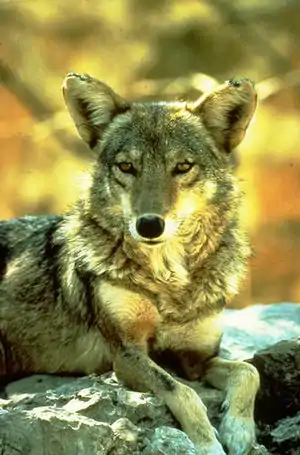 Coyote, Canis latran |
- 1 2 Minnesota Department of Natural Resources (2012), Mammals of Minnesota: Coyote, http://www.michigan.gov/dnr/0,1607,7-153-10370_12145_12205-60378--,00.html, retrieved October 1, 2012
- ↑ Tokar, E (2001), Canis latrans, http://animaldiversity.ummz.umich.edu/site/accounts/information/Canis_latrans.html, retrieved October 1, 2012
Gray Wolf
| Canis lupus (Gray Wolf) | |
|---|---|
|
Family: Canidae
Size: 4.5-6.0 ft (1.37-1.83m) in length, 40-175 lbs (18.14-79.38 kg) in weight
Description: The Gray Wolf is a large, densely furred dog with a bushy tail.[1] It is the largest of the Canidae family. Its long fur varies in color from pure white through gray and brown to black, and it generally resembles the German shepherd or husky.[2] It has long legs and small ears, and has a long muzzle.[3]
Similar Species: It is larger than a coyote, and has a broader snout and rounder, shorter ears. It is also larger than a domestic dog, has a broader nose pad, and a more massive skull with heavier teeth.[2][4]
Range: The Gray Wolf was once the most widely distributed mammal that could be found in Western Europe, Mexico, Canada, and in the United States. Now, it can be found in some parts of Canada, reintroduction sites in Wyoming and Idaho, Alaska, northeastern third of Minnesota, northern Wisconsin, Michigan Upper Peninsula, and the Cascade Mountains of northern Washington.[4][5]
Habitat: There is no particular habitat preference for the Gray Wolf, but it is mainly found in forests and tundra.[2]
Diet: It is a carnivore, and eats mostly large mammals such as deer, moose, caribou, elk, and wild boar, but it also eats smaller preys, livestock, carrion, and garbage.[5]
Activity: It is a social animal that usually travels in packs of 5 to 8 members that uses a dominance hierarchy to maintain order.[2] It is mainly crepuscular, but may be active by day.
Reproduction: The Gray Wolf breeds from January to April, with a gestation period of 63 days, and an average of 6 pups in a litter. It is only the dominant male/female wolf who mate and rear offspring.[4] It is sexually matured after 2 years, but often does not breed until its third year.
Lifespan: It may live up to 16 years, but 10 years is an old age for those in the wild.[2] |
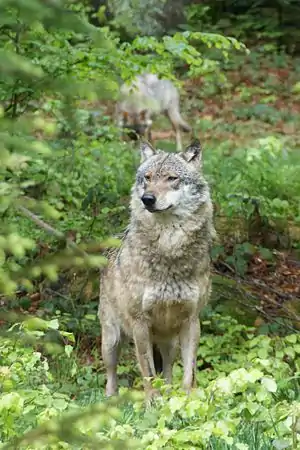 Gray Wolf, Canis lupus |
- ↑ Hazard, E. B. (1982), The Mammals of Minnesota, Minneapolis, MN: The University of Minnesota Press, pp. 116–119
- 1 2 3 4 5 Mech, L. D. (1974), "Canis lupus", Mammalian Species (37): 1–6, http://www.science.smith.edu/msi/, retrieved September 23, 2012
- ↑ Reid, F. A. (2006), Mammals of North America, Boston, NY: Houghton Mifflin Company, pp. 441–442
- 1 2 3 NatureServe (2012), "Canis lupus", NatureServe Explorer: An online encyclopedia of life (Version 7.1), http://www.natureserve.org/explorer, retrieved September 28, 2012
- 1 2 Mech, L. D.; Boitani, L. (2010), "Canis lupus", IUCN Red List of Threatened Species (Version 2012.1), http://www.iucnredlist.org, retrieved September 28, 2012
Gray Fox
| urocyon cineroargenteus (Grey Fox) | |
|---|---|
|
Family: Canidae
Size: 76-112.5 cm (30-44.3 inches) in total length. Weighs approximately 3.6-7 kg (7.9-15 lbs.) Male and Females look the same except females may be slightly smaller in size than male counterparts.
Description: The gray fox is medium sized with a stocky body, moderately short legs and medium-sized ears. It can be distinguished from the grizzled grey and red coat with dark points around the nose top of the head and back with a black tipped tail. The undercoat is gray. The Grey fox can be distinguished from other candid's by its widely separated temporal ridges which create a U shape.[1]
Range: The gray fox is widespread in forest, woodland, brushland, shrubland, and rocky habitats in temperate and tropical regions of North America, and in northern regions of South America.
Habitat: In eastern North America, the gray fox is most commonly lives where there are deciduous/southern pine forests interspersed with some old fields and woodlands. In western North America, it is commonly found in mixed agricultural/woodland landscapes, and shrub habitats. The species occupies forested areas and thick brush habitats in Central America, and forested montane habitats in South America. They may also occur in semi-arid areas of the south-western U.S. and northern Mexico where cover is sufficient.[2]
Diet: The gray fox is a solitary hunter and is primarily omnivorous. It will readily prey upon the eastern cottontail, voles, shrews, and birds in the eastern United States. In California, the gray fox primarily eats rodents, followed by other rabbit species such as jack rabbit, and the brush rabbit. In some parts of the Western United States the gray fox is primarily insectivorous and herbivorous. Fruit is also an important component of urocyon cinereogenteus’s diet and they seek whatever fruits are readily available, generally eating more vegetable matter and is therefore more omnivorous than any other fox species[3]
Activity: Grey foxes are nocturnal creatures meaning that they are primarily do their hunting/ foraging at night and dens in hollow trees, stumps or burrows during the day. Its ability to climb trees is shared only with the Asian Raccoon dog among canids. The grey fox has strong, hooked claws that allow it to climb up trees to escape predators such as the domestic dog or the coyote or to reach arboreal food sources. It descends primarily by jumping from branch to branch, or by descending slowly backwards as a house cat would do.[4]
Reproduction: During parturition and pup rearing, gray foxes use earthen dens, either dug themselves or modified from burrows of other species. They will also den in wood and brush piles, rock crevices, hollow logs, hollows under shrubs, and under abandoned buildings. Gray foxes may even den in hollows of trees up to nine meters above the ground. Den use diminishes greatly during non- reproductive seasons when gray foxes typically use dense vegetation for diurnal resting locations. Gray foxes reach sexual maturity at 10 months of age, although not all females breed in their first year. Breeding typically occurs from January to April with gestation lasting about 60 days. Litter size ranges from 1–10 and averages around four pups. Eyes of pups open at about 10–12 days. Pups accompany adults on foraging expeditions at three months and forage independently at four months. Females appear to be responsible to provision pups, although there is some evidence that males may also contribute to care of pups. Juveniles reach adult size and weight at about 210 days.[5]
Lifespan: It is rare for a gray fox to live longer than 4–5 years, although it has been reported that some individuals could live 14–15 years if kept in proper conditions in captivity.
Notes: The Grey Fox is unique from other candids because of the fact that they can climb trees easily using their back legs to quickly propel themselves up tree trunks. This unique behavior characteristic has given them the nicknames "tree fox" and "racoon dog".
While their fur in the past has some value for fur trade, because of their duller gray coat color,grey foxes were never as highly sought after for fur trade as the red fox. |
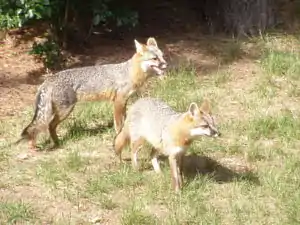 urocyon cineroargenteus Grey Fox |
- ↑ "Urocyon Cinereoargenteus", Mammalian Species (189): 283–294., 1979, http://www.science.smith.edu/departments/Biology/VHAYSSEN/msi/pdf/i0076-3519-189-01-0001.pdf, retrieved October 10, 2012
- ↑ "Urocyon Cinereoargenteus", Mammalian Species (189): 283–294., 1979, http://www.science.smith.edu/departments/Biology/VHAYSSEN/msi/pdf/i0076-3519-189-01-0001.pdf, retrieved October 10, 2012
- ↑ [:http://www.iucnredlist.org/details/22780/0 Urocyon Cinereoargenteus], 2011,
- http://www.iucnredlist.org/details/22780/0, retrieved October 10, 2012
- ↑ [:http://www.iucnredlist.org/details/22780/0 Urocyon Cinereoargenteus], 2011,
- http://www.iucnredlist.org/details/22780/0, retrieved October 10, 2012
- ↑ "Grey Fox", Canids: Foxes, Wolves, Jackals, and Dogs: 92–98., 1982, http://www.carnivoreconservation.org/files/actionplans/canids.pdf, retrieved October 10, 2012
Swift Fox
Single Page View Field Guide/Mammals/Swift Fox
Red Fox
| Vulpes vulpes (Red Fox) | |
|---|---|
|
Family: Canidae
Size: Average size: 15in to 16in tall at shoulder
Length: about 3ft Tail: 13in Weight: 8lbs-15lbsDescription: The red fox is a medium size predator and is most common across Minnesota, even in the Twin Cities and suburbs¹. They are cousins to the dog. These red fox have rusty-red coat with white-tipped bushy tail, and black legs, ears and nose. There are also other colors such as nearly solid black, silver-black and red bisected by dark bands that are across the back and shoulder which sometimes this is called a cross fox¹.
Habitat: Red fox live in many ranges of habitat, ranging from forest to open fields and are found throughout Minnesota. They often have den in woodchuck or badger holes found in dense woods¹. Most dens are up to 40 feet and used for nursery because red foxes prefer to sleep in open areas even during the winter time¹.
Diet: They eat rats, mice, rabbits, ground squirrels, birds, snakes, fish, insects, berries nuts, and seeds. Their diet can be flexible from their home habitat². They will also eat fruit, vegetable, fish frogs, and even worms. Among humans, they will mostly eat garbage and pet food. Red fox hide their uneaten food under litter or bury it in holes. They are one of the few predators that actually store food items¹.
Activity: They tend to be solitary animals and will always hunt alone¹. The red fox are active both during the day and night but likely to hunt during twilight and in the evenings.
Reproduction: They mate during the winter, February in particular and 52 days before offspring. Newborns are nurse for ten weeks and will be independent in seven months. At birth, their colors are brown and gray. Then a new coat will grow in toward the end of the first month². Both parents care after their young. These red foxes can reproduce at age one. |
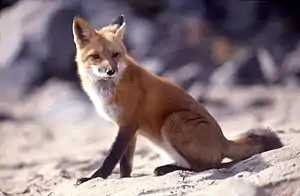 |
References
Bears
Black Bear
| Ursus americanus (Black Bear) | |
|---|---|
|
Family: Ursidae
Size: The total length of a black bear grows up to 6 feet (1828.8 mm) long with a tail length of 3-5 inches (76.2-127mm). With four feet on the ground, it stands up to 2 feet. (609.6mm) tall and weighs from 220-330 pounds (99.8-149.68 kg).[1]
Description: Black bears usually have black or dark brown furs with a lighter brown snout. They have small eyes, round ears, and a straight or rounded snout. Some of these black bears have white chest patch. They can stand and walk, but they usually stand on all four legs. They can dig and climb trees because of their curved claws.[1]
Similar Species: This species has black or dark brown fur which is similar to grizzly bears'. Grizzly bears have furs that are lighter. Black Bears also have a straighter and more round snout that is different from a grizzly bear’s “curved in” face.[2]
Range: Black Bears can be sighted from Alaska, east of Canada, most of the United States, to central Mexico.[2] As for our state, they are usually seen in northern parts of Minnesota.
Habitat: They are usually in areas that have a lot of vegetables, tall grassy areas, woodlands, forests, and water access areas.
Diet: If they are disturbed during their hibernation in winter, they tend to eat hollow trees, rock cavities, and open-ground trees. During winter, black bears are known to hibernate for about seven months. During spring, they usually eat grass, insects, and vegetables. Overall, they eat fruits, nuts, acorns, berries, rarely other animals, and garbage composed by humans.[3]
Activity: Winter, Black Bears hibernate in “hard to get in” places for about seven months. Spring, they move to lower parts of grounds (e.g. bottom of a mountain) then higher parts in summer/fall as foods become available.[2]
Reproduction: Mating season only happens once per year and it usually starts late May to mid July. Black Bears mate when they are 4-5 years old. Female bears will mate every other year after pregnancy. It takes about 220 days to give birth including 10 weeks delay of fertilizing eggs. Female Black Bears usually give birth to 1-6 cubs. 2-3 cubs usually survive. The cub stays with the mom for 1-1 ½ year before separating to begin their own lives.[1]
Lifespan: Black Bears live up to 30 years of age, but most only live up to 10 years because of hunters.[2]
Notes: The black bear got its name from the color of its furs. Also, some black bear are confused for brown (grizzly) bears because of their dark brownish furs. They are also hunted by humans for food or trophies. |
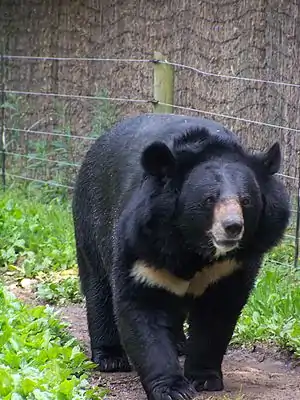 Black bear |
- 1 2 3 Plunkett, Richard (2011), Black Bears, http://www.caveslime.org/kids/cavejourney/SpeciesAccounts/BlackBears.html, retrieved October 7, 2012
- 1 2 3 4 Dewey, Tanya; Kronk, Christine (2012), Ursus americanus: American black bear, http://animaldiversity.ummz.umich.edu/accounts/Ursus_americanus/, retrieved October 7, 2012
- ↑
Raccoons
Northern Raccoon
| Procyon Lotor (Northern Raccoon) | |
|---|---|
|
Family: Raccoons
Size: The average length of the Northern Raccoon is 24.96-37.4 in (634-950mm). The average length tail of the tail is 7.8- 15.9 in (200-405mm). It has an average weight is 14.9 lbs. (6.76kg)[1]
Description: The Northern Raccoon has a brown-black facial mask and areas of white hair. Its color varies from an iron grey to black/brownish tints. This species has five toes on each foot with short, compacted claws. Their hands are made to grasp objects and help support their legs and the weight of their body.[1]
Similar Species: This species is distinguished between others by the colors and lines on its face. The skull size is also a distinguishing feature because it is significantly smaller than the body.[1]
Range: The Northern Raccoon is typically found in North America, starting from southern Canada to the southern parts of Mexico. This species can be most commonly found in urban metropolitan areas. In Minnesota specifically, the Northern Raccoon is greatly populated in all parts of the state.[2]
Habitat: This species depends on large vertical structures to climb if they feel threatened or need to escape. They prefer forests and other covered areas so they can hide from predators and hunters.[2]
Diet: This species eats insects, plants, and mice. Fruit, nuts, plants, and worms are the most common. Depending on the season, a raccoon will eat a variety of foods.[3]
Activity: The Northern Raccoon is nocturnal. They prefer to hunt and eat during the night and sleep or mate during the day. They do not hibernate.[4]
Reproduction: This species mating season is January to March. The litter size is 2-3 babies. The baby raccoons are weened by mid-summer after their birth and are free to live on their own by autumn.[1]
Lifespan: The average lifespan of an adult raccoon is 9-11 years of age.[4]
Notes: The Northern Raccoon is the raccoon that run in front of your car. It is the animal that can see at night and thrives in all parts of Minnesota. It is known for its color range of grey, black, and white. Its face mask is what distinguishes itself from other raccoons. Because this raccoon ranges in many parts of the United States it is on the “least concerned” list when it comes to extinction. This is an example of an animal that is very adaptive to human life. It can survive and thrive in a city or the country side and has increasing population size in suburban areas. There are very few threats to the northern raccoon. Hunting the raccoon has increased in many regions. It is commonly hunted using traps, poison, or firearm. |
3.JPG.webp) Northern Raccoon |
- 1 2 3 4 Joerg-Henner, Lotze; Anderson, Sydney (1979), Procyon Lotor, The American Society of Mammalogists, pp. 1–8
- 1 2 Cuaron, Timm; Helgen, Reid (2008), Procyon Lotor, IUCN Red List of Threatened Species, p. 1
- ↑ Beasly, James; Atwood, Todd (2012), A Comparison of methods for estimating raccoon abundance: Implications for disease vaccines programs, Journal of Wildlife Management, pp. 1290–1297
- 1 2 #if:
Skunks
Striped Skunk
Eastern Spotted Skunk
Weasels
Wolverine
Single Page View Field Guide/Mammals/Wolverine
American Badger
River Otter
American Marten
Fisher
American Mink
Least Weasel
Ermine
Long-tailed Weasel
Hoofed Animals
Deer
Moose
Elk
Single Page View Field Guide/Mammals/Elk
White-tailed Deer
Mule Deer
Caribou
Single Page View Field Guide/Mammals/Caribou
Pronghorns
Pronghorn
Bovines
American Bison
Single Page View Field Guide/Mammals/American Bison